When I reached the Hermitage of St. Sava, I first made a nice break to rest well, but it was quite clear that I could not stay there forever. Since I was not quite fit, I was already tired and would not mind skipping the climb to the top of mount Kablar. After all, I had been there several times and have photos to prove this, but... Already while climbing up here, following the steep path to Savina Voda, it was clear to me that the descent could be quite dangerous for me and my manoeuvring capabilities. So, there was nothing to do apart from moving on along the trail in the direction of the summit.
When one leaves the Hermitage of St. Sava, the trails goes down for a short while, but this may be deceiving, for one cannot get to the top by going down.
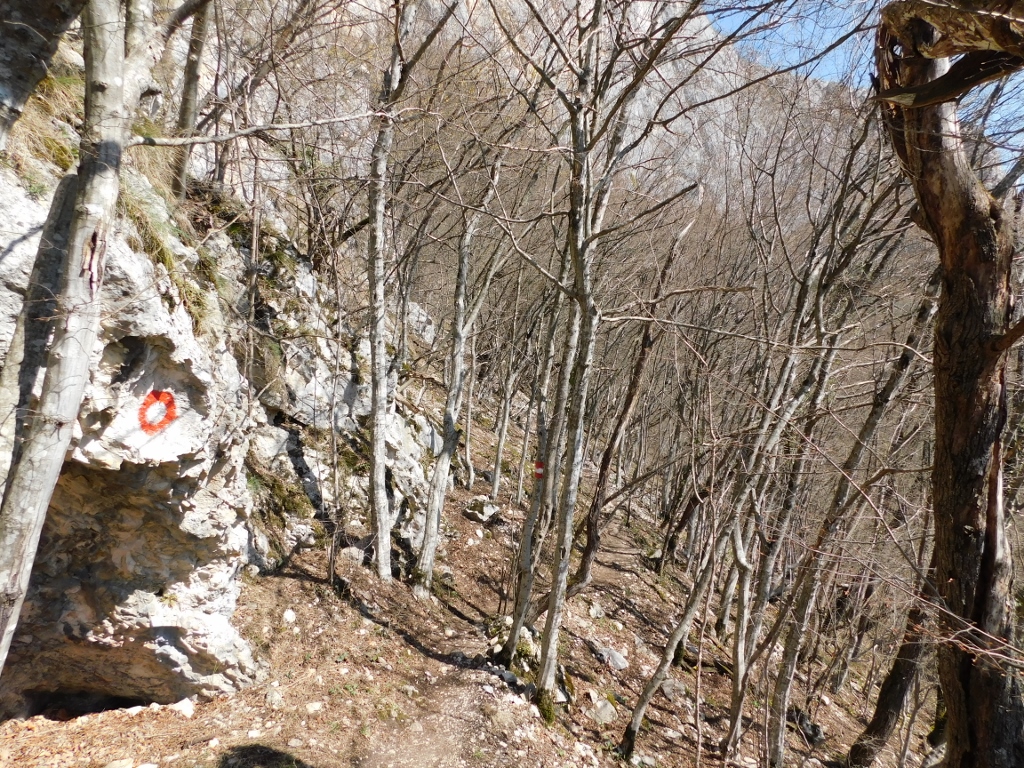 Continuation of the hike after the Hermitage of St. Sava
Continuation of the hike after the Hermitage of St. Sava
I still had a lot to cover in order to get to the top and the view upwards was certainly dispiriting.
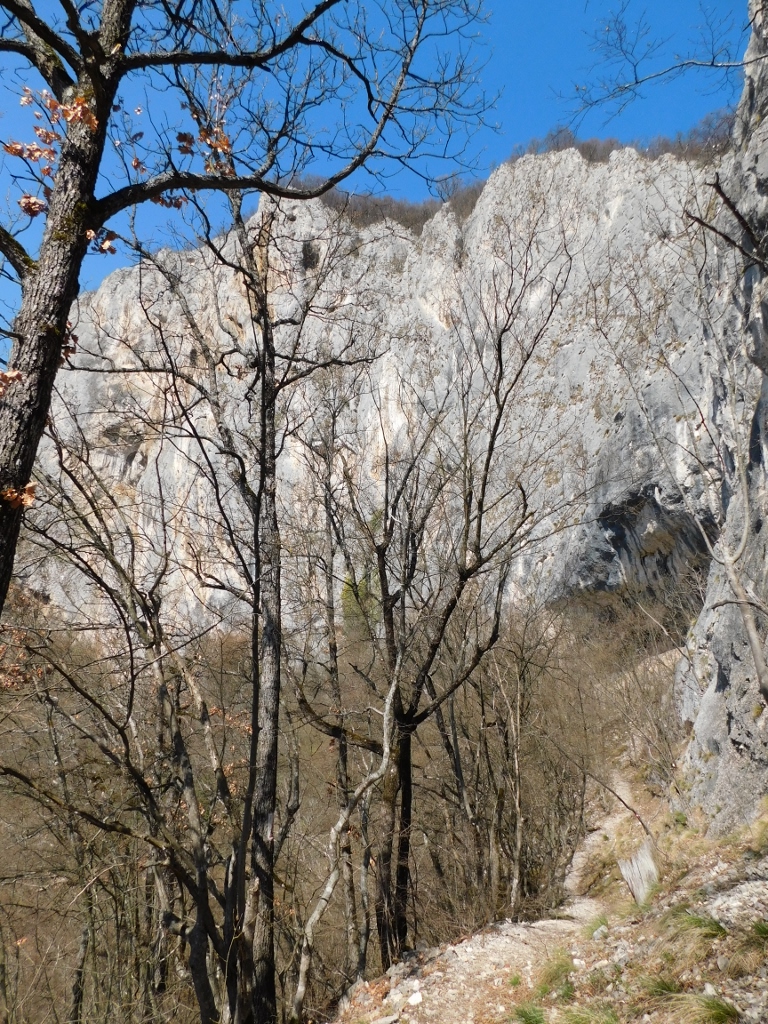 Trails and landscape after the Hermitage of St. Sava – I’m supposed to get to the top
Trails and landscape after the Hermitage of St. Sava – I’m supposed to get to the top
So, after going down for a short while, the trail starts upwards once again. This section is also very steep and significantly longer. The time foreseen for it is double the time needed from the beginning to Savina Voda (which also took me more than forecasted). Needless to say, I did not cover this section for the foreseen time either – instead of one hour and a half, it took me well over two hours. And very difficult two hours at that. So, I made short breaks more often, usually in order to take a photo or two.
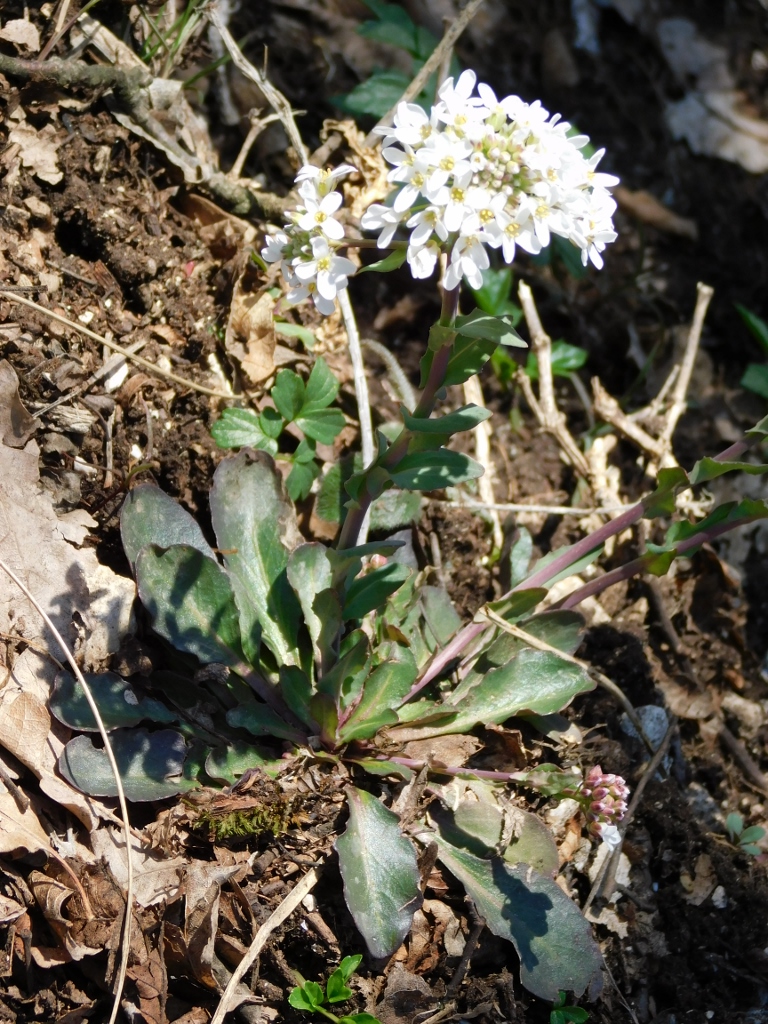 Wild flowers, but I don’t know which
Wild flowers, but I don’t know which
At some point I started climbing along a funnel full of loose soil and pebbles. I almost had to crawl in order not to slip and slide down. In addition to my trekking poles, I intensively used all the trees I could grab. Then, at one moment, I simply sat down on a rock in order to catch my breath, safely protected by some fallen trees from sliding downwards.
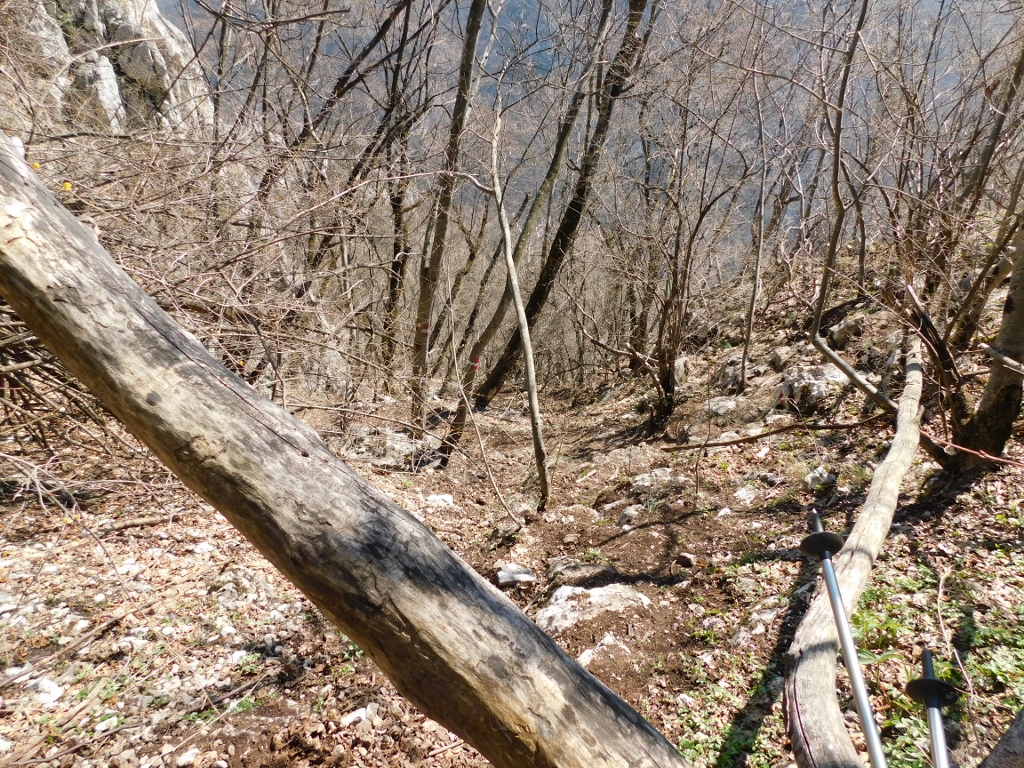 Wild steep path through the woods
Wild steep path through the woods
I was worried here, about where I was, what I was doing, etc., but there was no going back. On the other hand, I could not help but notice some stunning flowers belonging to dogtooth violet (Erythronium dens-canis).
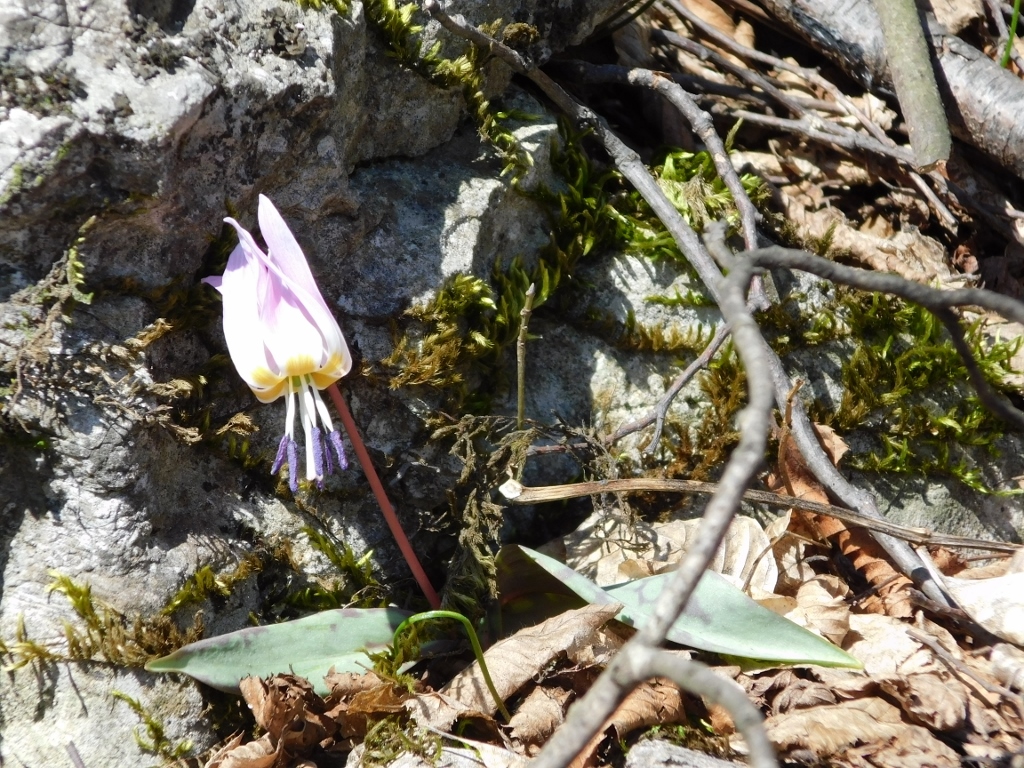 Dogtooth violet
Dogtooth violet
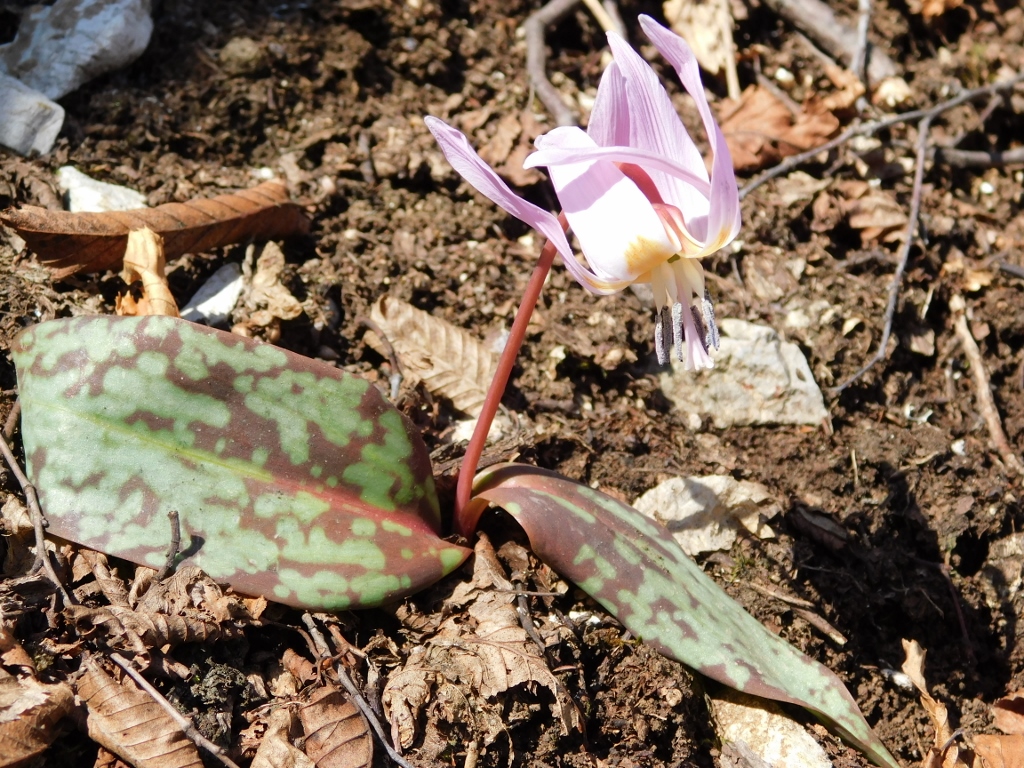 Dogtooth violet
Dogtooth violet
Then, finally, towards the end of that funnel, I noticed a mark on one of the trees and I must admit I felt relieved knowing that I was on the right track. And yet, when I got there, I came across the proper trail and it was only then that I realised I had made a mistake earlier, missing the right way. That narrow trail must have been steep as well, but not so dangerously loose as the funnel I had to climb through, rather more compacted.
Be as it may, the strenuous climbing towards the top continued, but now I was very careful not to miss the trail again. This was not the place for something like that.
The trails are well maintained and in a couple of places there are secured fabulous viewpoints, so I certainly took the opportunity to make photos from there. It seemed as if the Zapadna Morava was right under my feet.
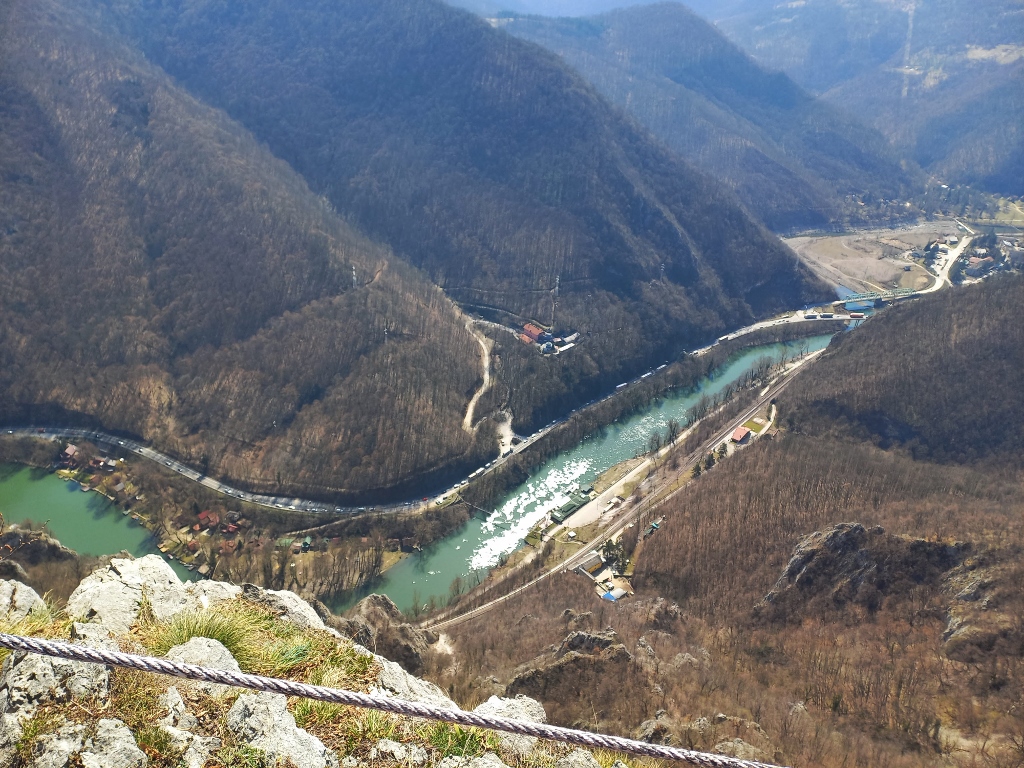 View at the Zapadna Morava, Monastery of the Transfiguration and Ovčar Banja
View at the Zapadna Morava, Monastery of the Transfiguration and Ovčar Banja
 View at the Zapadna Morava, Monastery of the Transfiguration and Ovčar Banja
View at the Zapadna Morava, Monastery of the Transfiguration and Ovčar Banja
But, the view at the surroundings was stunning, too.
 View from the viewpoint (mount Ovčar is to the left)
View from the viewpoint (mount Ovčar is to the left)
If one looks a little better at the photo above, it is possible to notice something resembling a white patch on the north slope of mount Ovčar. This was indeed snow, right next to the Monastery of the Meeting of the Lord in the Temple. This is what it looks like when zoomed in.
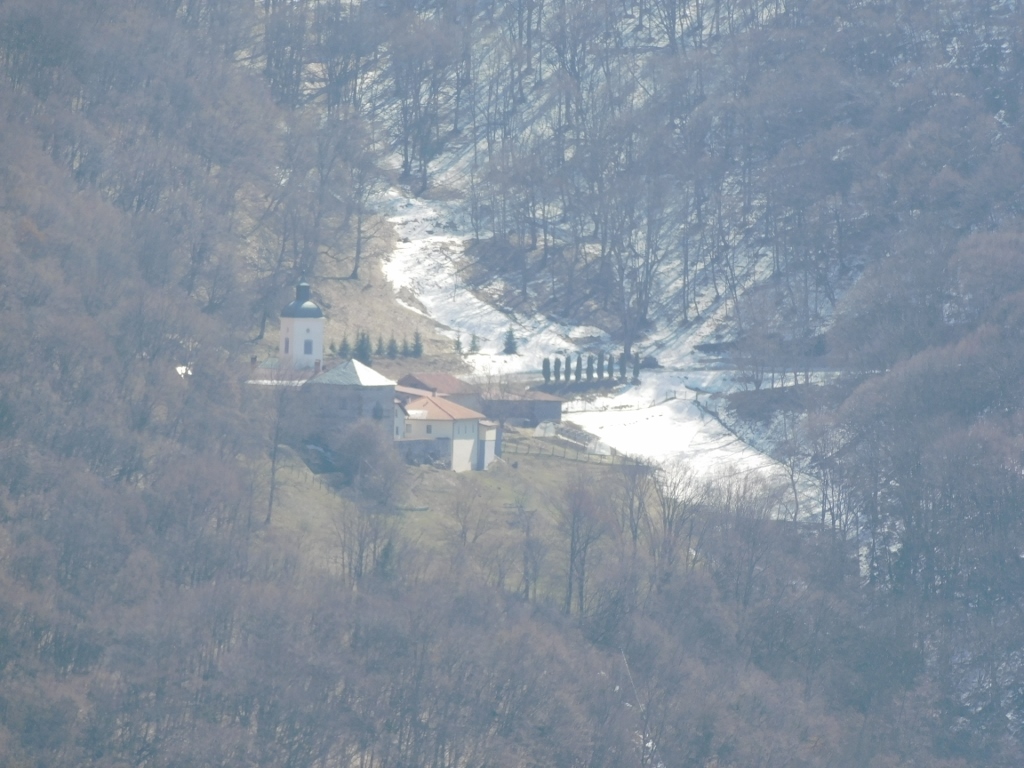 Monastery of the Meeting of the Lord in the Temple on mount Ovčar
Monastery of the Meeting of the Lord in the Temple on mount Ovčar
While I was standing there, I could also watch some birds flying constantly around the high cliffs of Kablar. As far as I could tell, these were ravens.
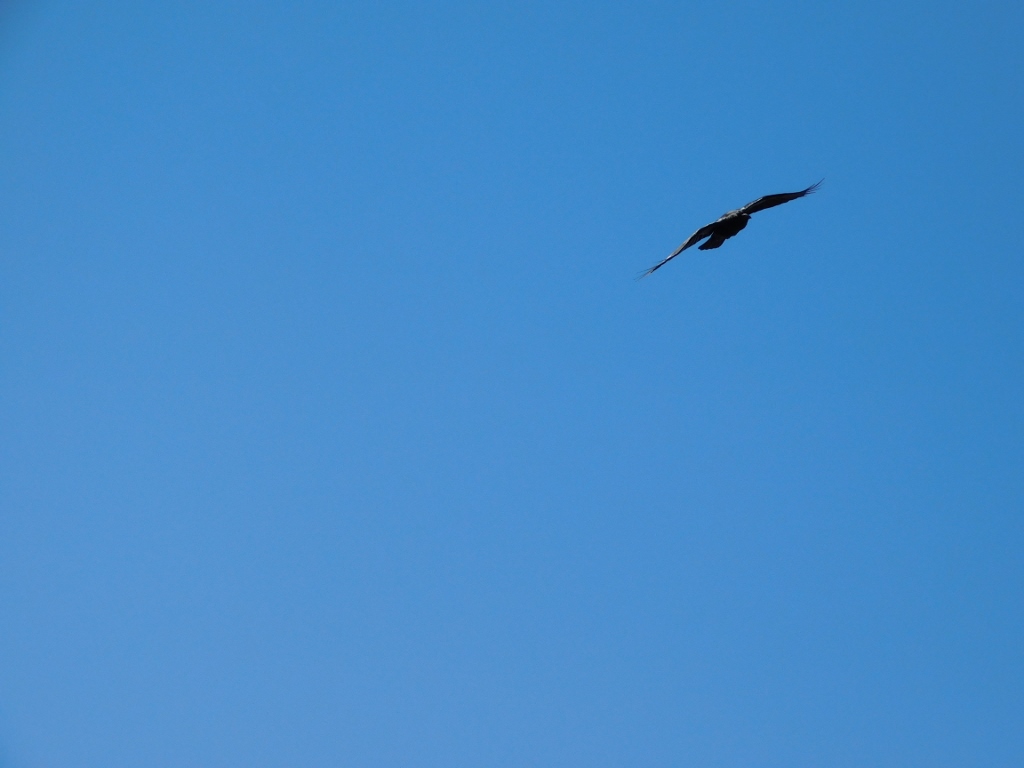 A raven above Kablar
A raven above Kablar
All this time I was practically climbing along the south slope of Kablar, but in order to get to the very top when hiking (not when alpine climbing), towards the end one has to move to the north side of the mountain. I came across some snow there.
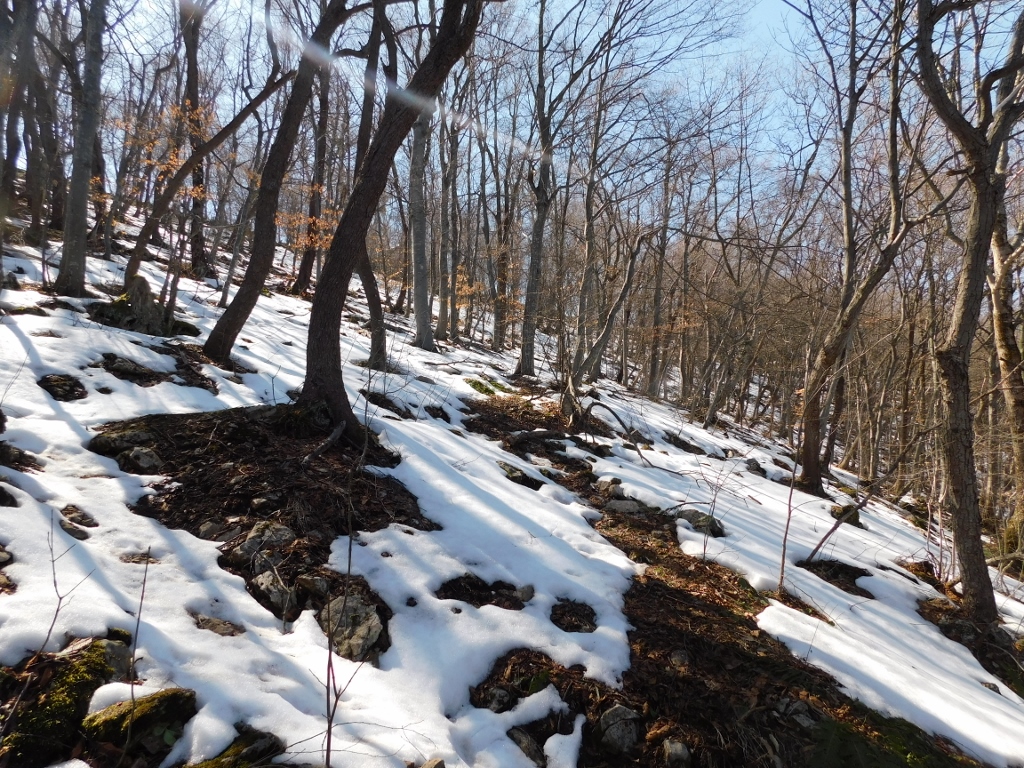 North side of Kablar around the middle of March
North side of Kablar around the middle of March
Here I had to take care lest I slipped on the wet snow and the mud underneath, but I soon reached the top successfully. In fact, I did not get to the summit itself, but rather I climbed to a platform used as a viewpoint that is installed a couple of metres below the elevation of the top, but I was certainly in no mood to be petty. First I sat down on the platform, followed by lying down in order to calm my breathing, only to lift my legs up in order to have an even better rest. It was only then that I got up and went to the fence to see why I climbed all the way here. Well, it think it was worth it in the end, wasn’t it?
 View from the platform on the top of mount Kablar at the meanders of the Zapadna Morava and mount Ovčar
View from the platform on the top of mount Kablar at the meanders of the Zapadna Morava and mount Ovčar
 View from the platform on the top of mount Kablar at the meanders of the Zapadna Morava, mount Ovčar and Ovčar Banja
View from the platform on the top of mount Kablar at the meanders of the Zapadna Morava, mount Ovčar and Ovčar Banja
Then I also got my mobile phone out in order to be able to send a couple of photos to some friends. The mobile phone adds more blue colour, but it does not ruin the presentation of the landscape’s beauty.
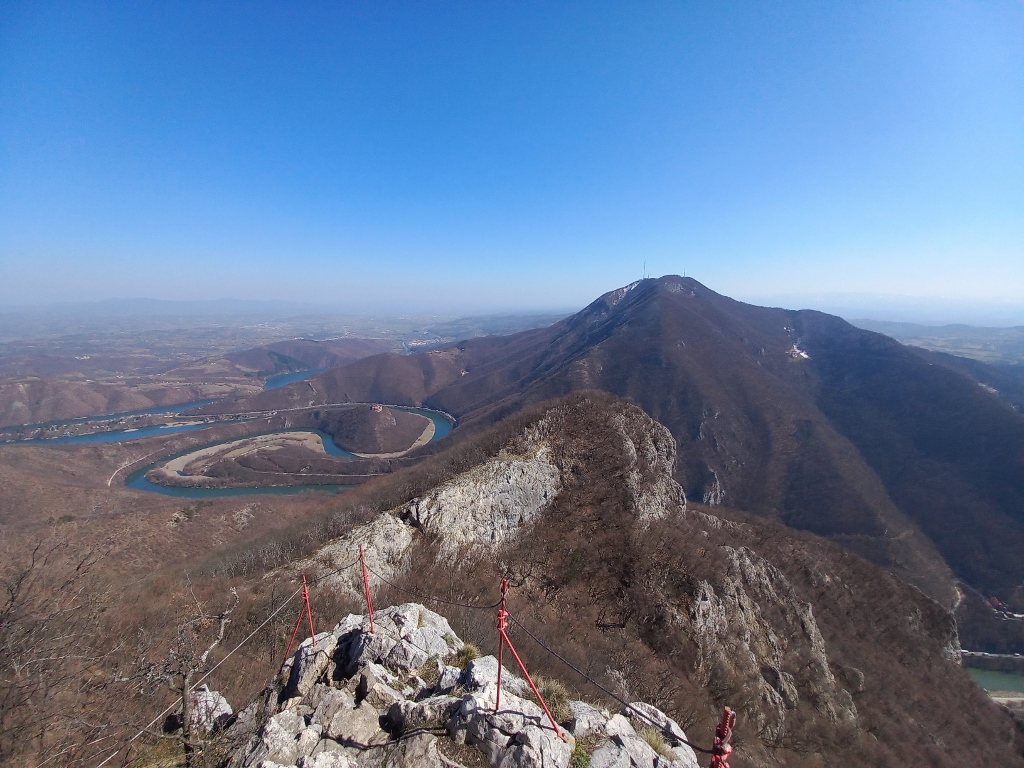 View from the platform on the top of mount Kablar at the meanders of the Zapadna Morava and mount Ovčar
View from the platform on the top of mount Kablar at the meanders of the Zapadna Morava and mount Ovčar
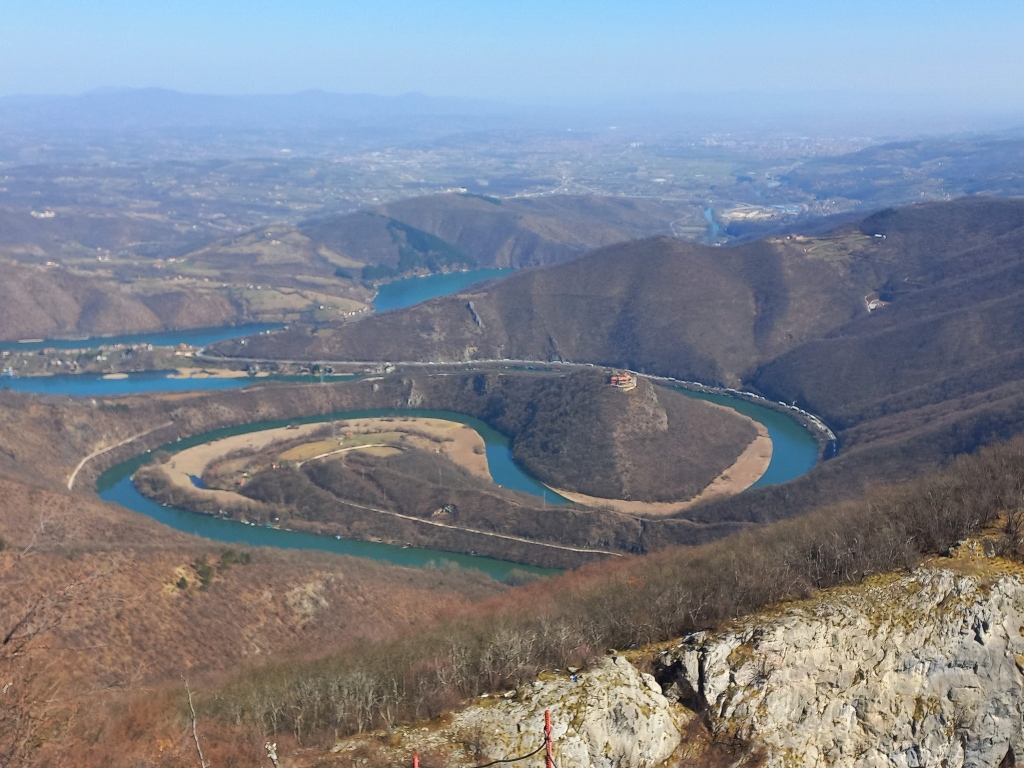 Meanders of the Zapadna Morava
Meanders of the Zapadna Morava
By the way, the plan for my further hiking was to go down to the Monastery of St. John (Jovanje) which is at the foot of the Monastery of the Assumption of the Theotokos (Uspenje) that can be seen on the top of one of the two “fingers” around which the Zapadna Morava winds (Jovanje is on the side that cannot be seen in the previous photo). Please notice how far this is from the place where I took this photo.
Needless to say, sending photos from this spot would not be worth it, if I did not make a selfie as well.
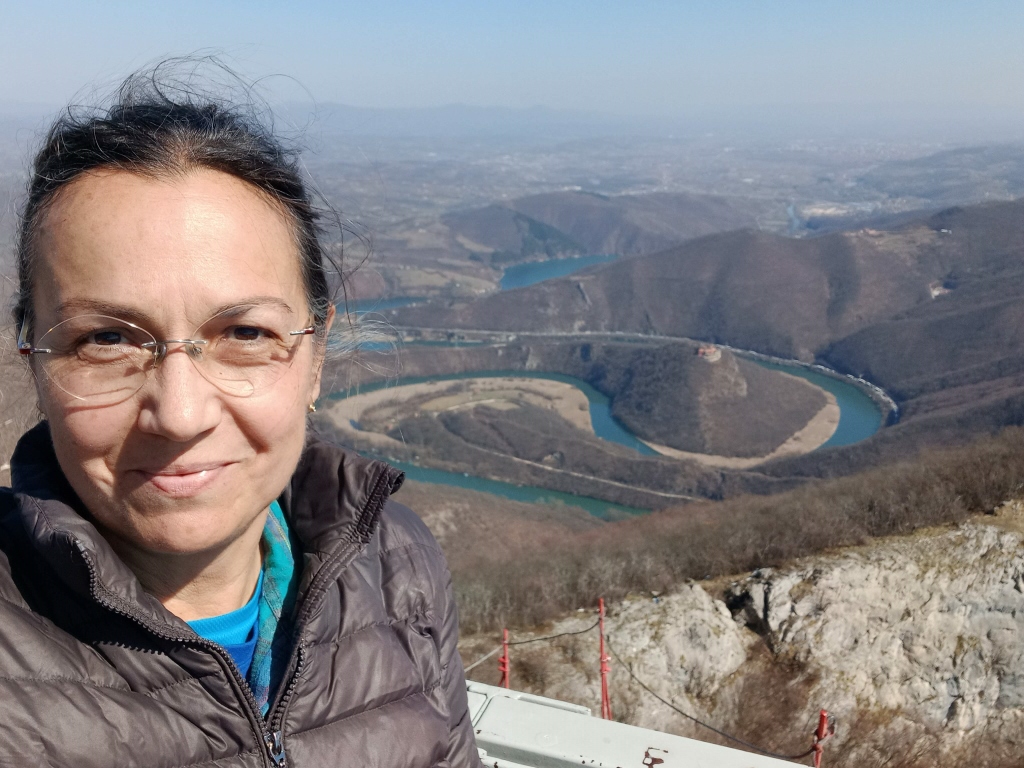 Self-portrait with meanders of the Zapadna Morava
Self-portrait with meanders of the Zapadna Morava
I also looked once more at mount Ovčar and Ovčar Banja. The next photos shows again the Monastery of the Meeting of the Lord in the Temple on mount Ovčar and it is almost identical to the relevant photo in the previous part of this story, but it is still possible to observe the difference in the elevation from which I took the photos.
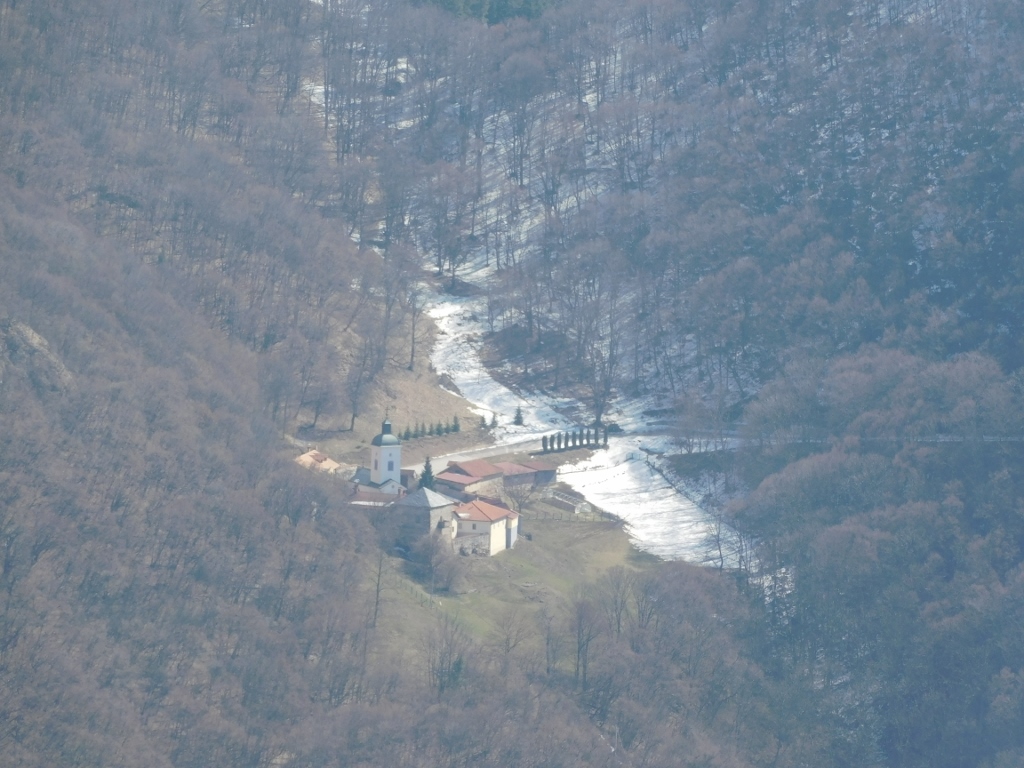 Monastery of the Meeting of the Lord in the Temple
Monastery of the Meeting of the Lord in the Temple
In addition, I almost had the bird’s-eye view at Ovčar Banja in which I stayed these days. As it can be seen, this spa is a rather small place.
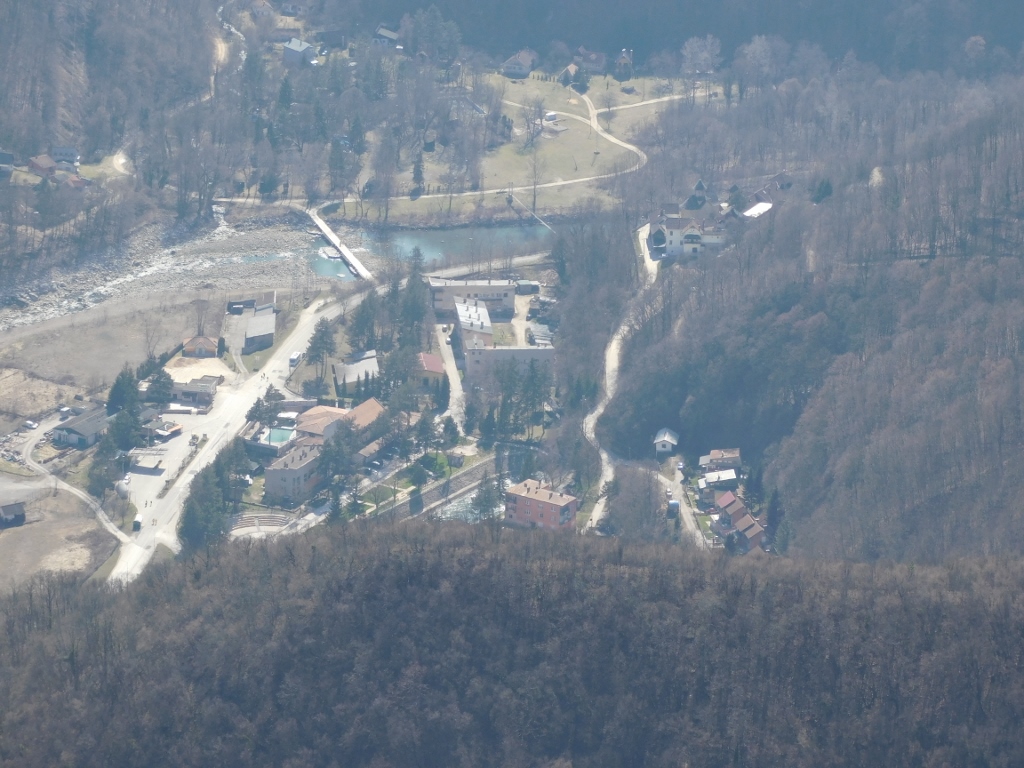 View at Ovčar Banja from the top of Kablar
View at Ovčar Banja from the top of Kablar
After I had recovered a little and taken some photos, I got the food I brought for “lunch” out of my backpack and had a nice “meal” there. Then a few other hikers arrived. One girl seemed to be a pro, so I asked her for advice as to how to get to my next destination. I had a rough, but not completely clear idea. As I’ve mentioned before, in the past I used to hike here led by somebody else, so I did not know all the details about further trails. This girl gave me the basic instructions and that was quite enough in the beginning.
Namely, as I’ve said, I wanted to go to the Monastery of St. John and in order to do this I had to go around a little. Unlike the south side of Kablar which is a little “wild,” its north side is quite “tame.” I enjoyed it immensely, despite the fact that the tiredness did not decrease – it only changed its form.
To start with, I went down to a wide dirt road that runs along the watershed of Kablar. I saw a sign pointing to the formal peak of Kablar that was only 5 minutes away, but I had no intention of climbing anywhere any further. I was interested only in going down or walking over flat surfaces.
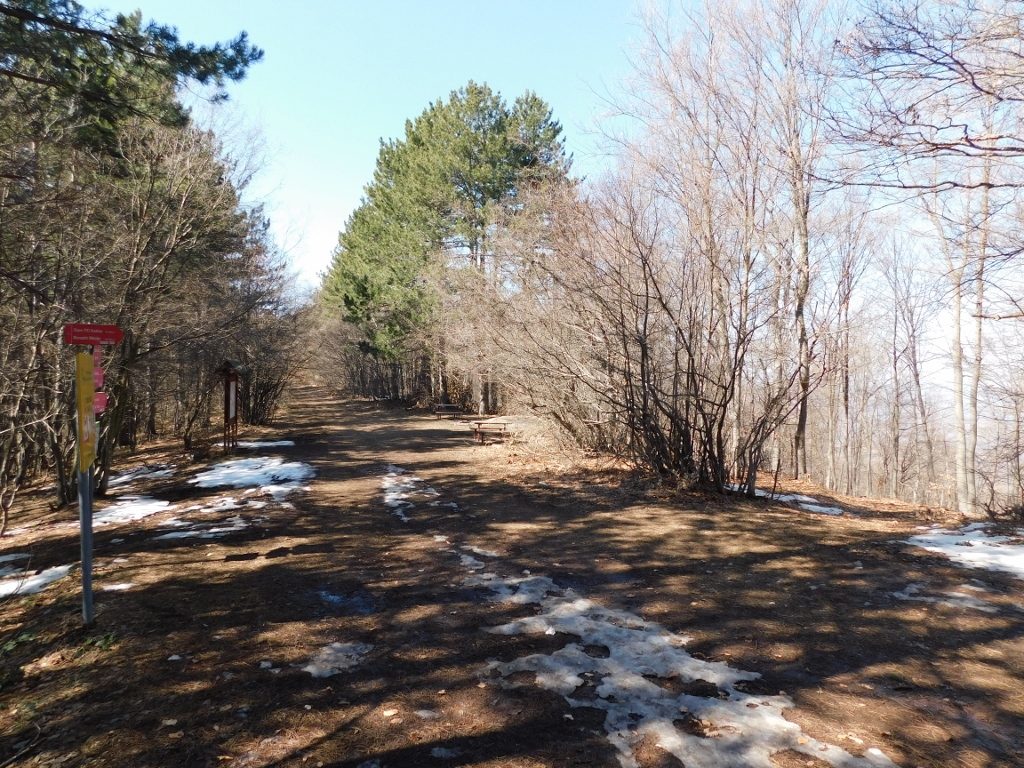 Road along the watershed of Kablar
Road along the watershed of Kablar
From here I continued to descend along the north slopes of Kablar, following a dirt road that exists there. There was relatively a lot of snow.
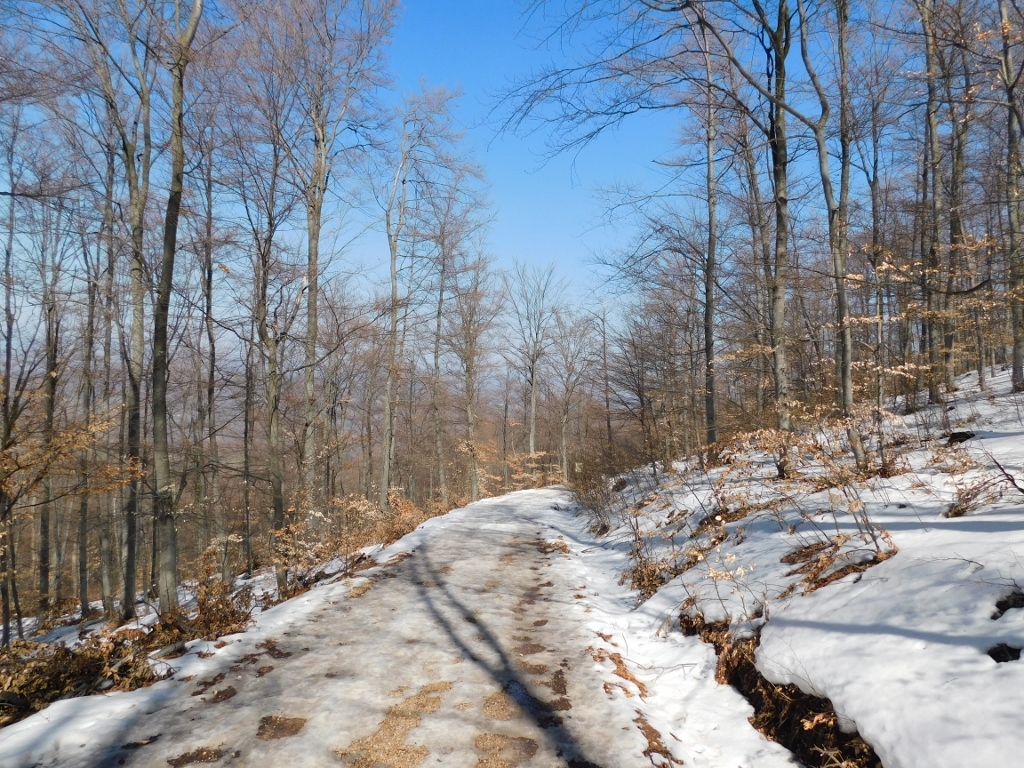 Beginning of my descent from the top of Kablar
Beginning of my descent from the top of Kablar
At some point I stopped and fixed my trekking poles in the ground in order to illustrate that in some spots there was almost 10 cm of snow, although it was quite clear that it was the end of the season and the spring was well on its way.
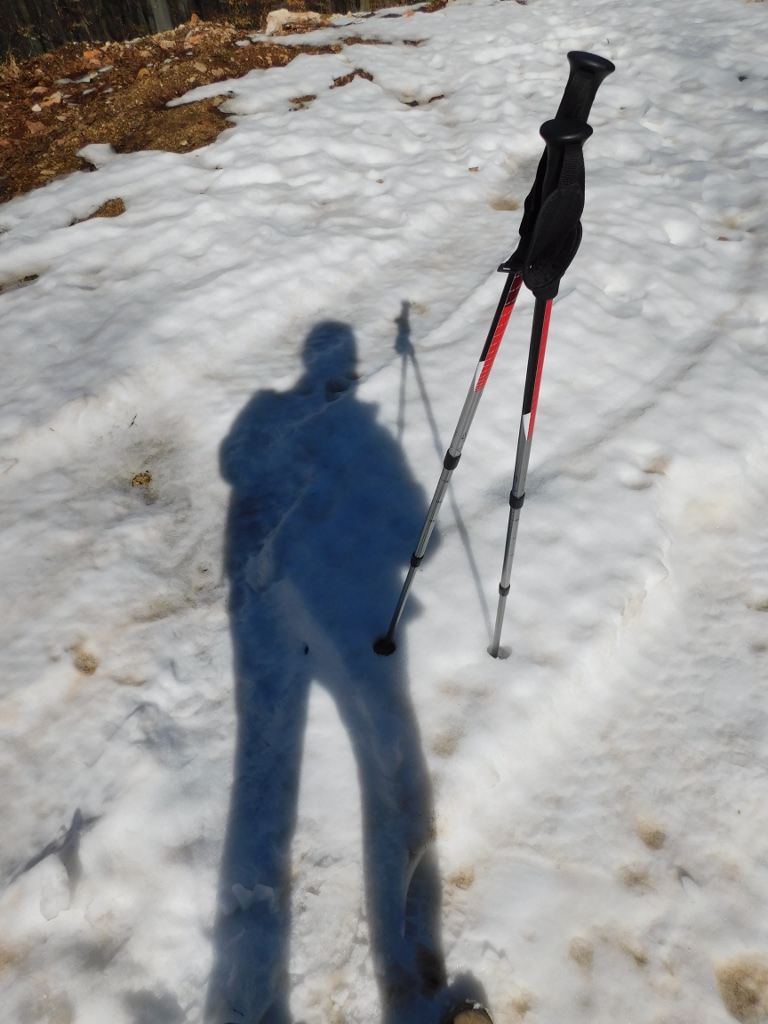 Snow on the north side of Kablar
Snow on the north side of Kablar
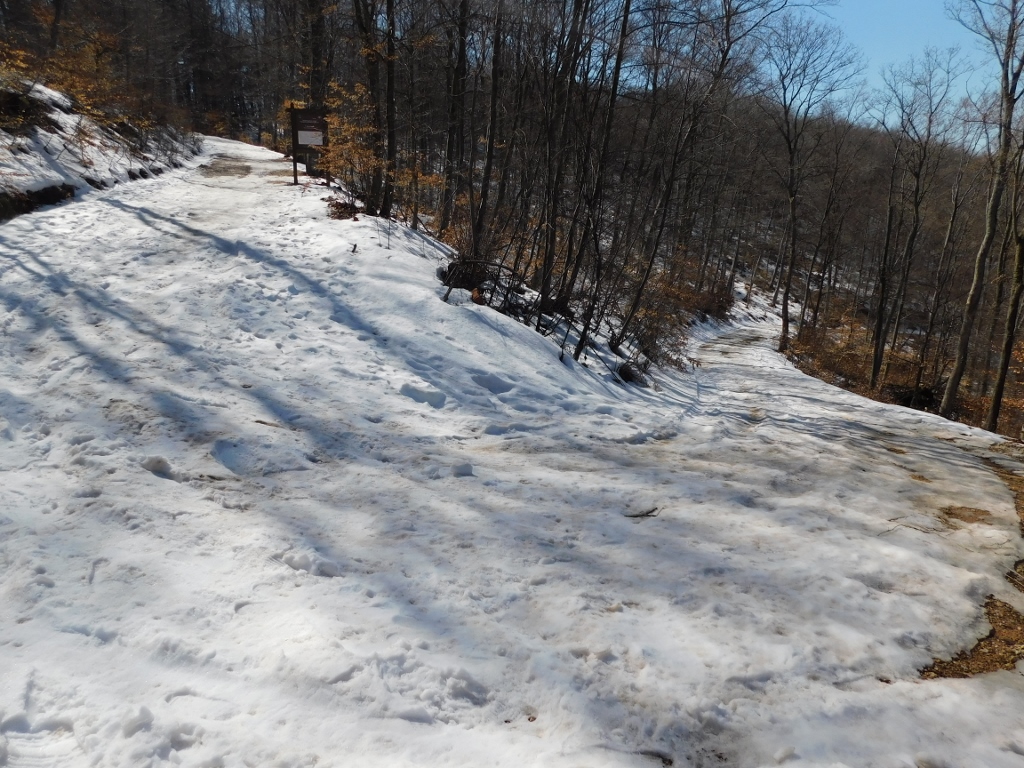 Snow on the north side of Kablar
Snow on the north side of Kablar
However, very soon the snow disappeared and only the tame landscapes of the early spring could be seen.
 Lower parts of the north side of Kablar in the early spring
Lower parts of the north side of Kablar in the early spring
 Lower parts of the north side of Kablar in the early spring
Lower parts of the north side of Kablar in the early spring
It was significantly easier for me to walk here, so regardless of the distance I was covering, I descended comparatively quickly, but I still had a lot in front of me. The following photo shows mount Ovčar on the right-hand side, while on the left-hand side there is a whitish “patch” on the top of the “finger” or the promontory of the Zapadna Morava. This is the Monastery of the Assumption of the Theotokos, while I was going to the Monastery of St. John that is behind the former and closer to the river.
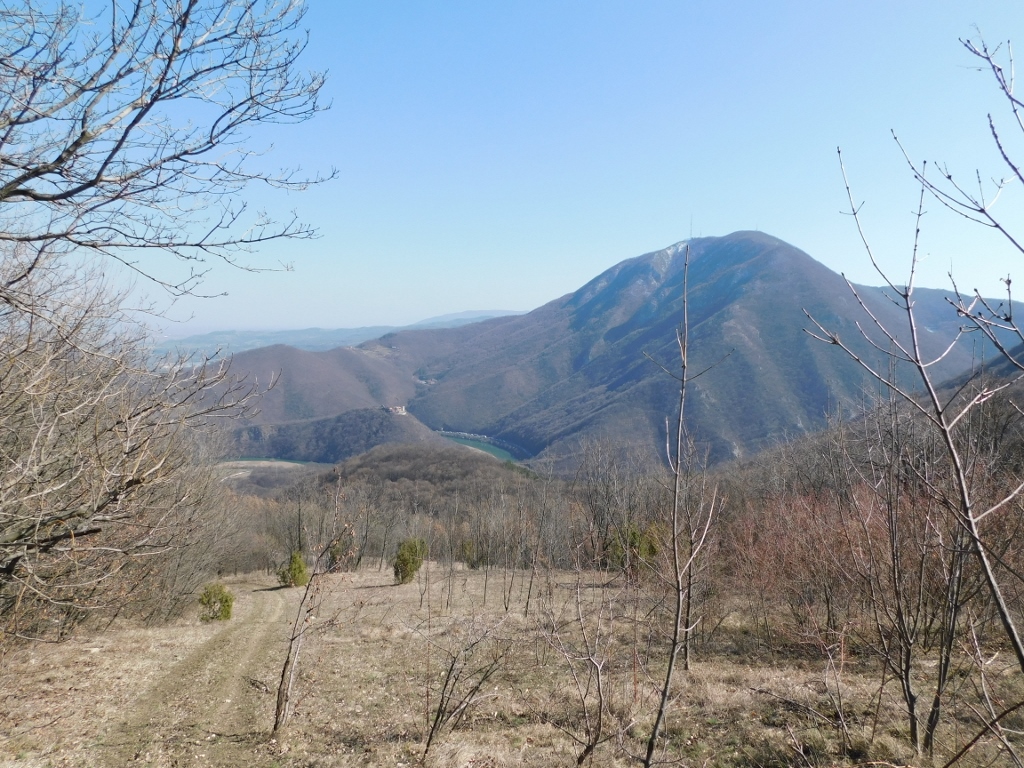 The goal is still far away
The goal is still far away
There are also signs for hikers here, but at some point I could see that the signs pointed either towards the Zapadna Morava closer to Ovčar Banja or where to go in order to get to Čačak on foot, while I needed something “in-between.” It was clear that I would have to improvise. So, I left the trail and headed straight across a meadow. After all, all the time I could see in front of me where I was going, so I did not worry.
 Tame landscapes in the early spring
Tame landscapes in the early spring
Although I felt certain doubt from time to time regarding my choice of the route, wondering if I would be better off going to an asphalt road that runs over a hill here, eventually I got to a wide trail which I was certain led in the desired direction.
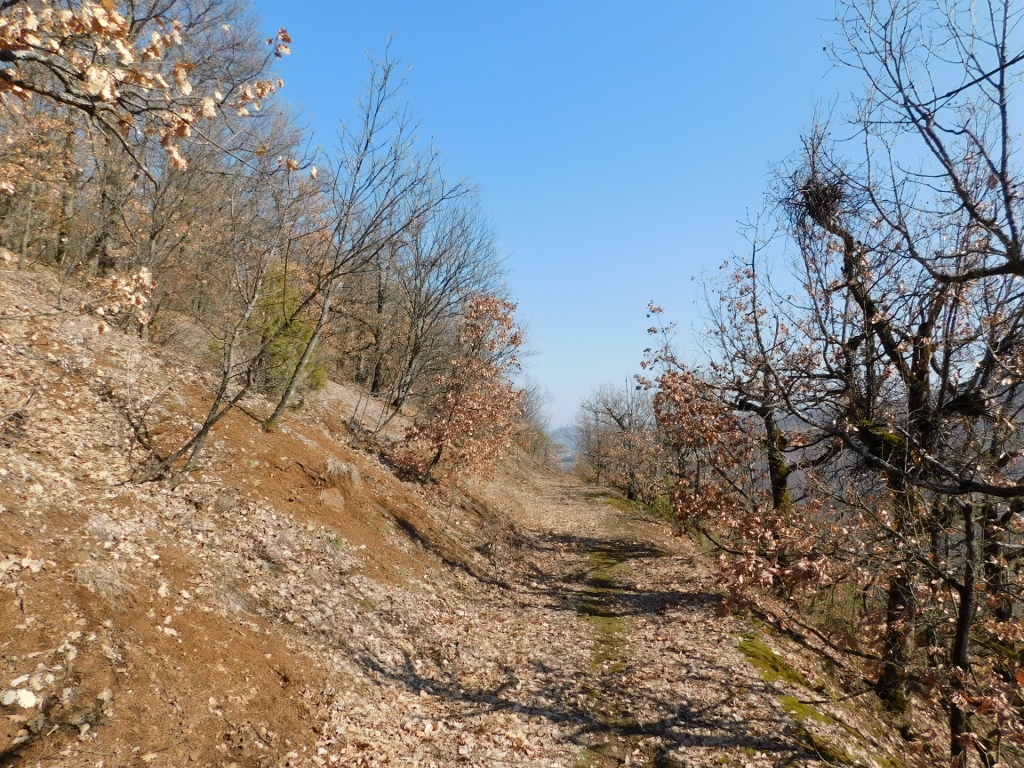 On the right road again
On the right road again
Now I was no longer breathless and I did not make breaks in order to recuperate or have rest, but I had to stop often nonetheless in order to take photos of the details around me. For here, I came across a myriad of wonderful wild flowers.
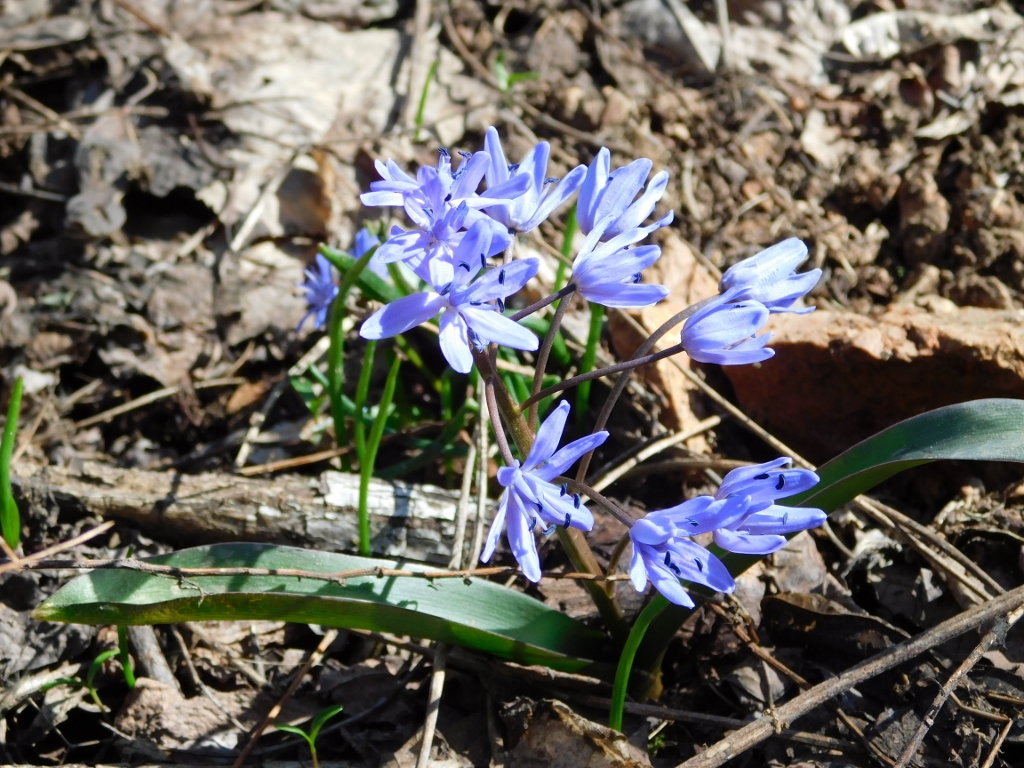 Alpine squill (Scilla bifolia)
Alpine squill (Scilla bifolia)
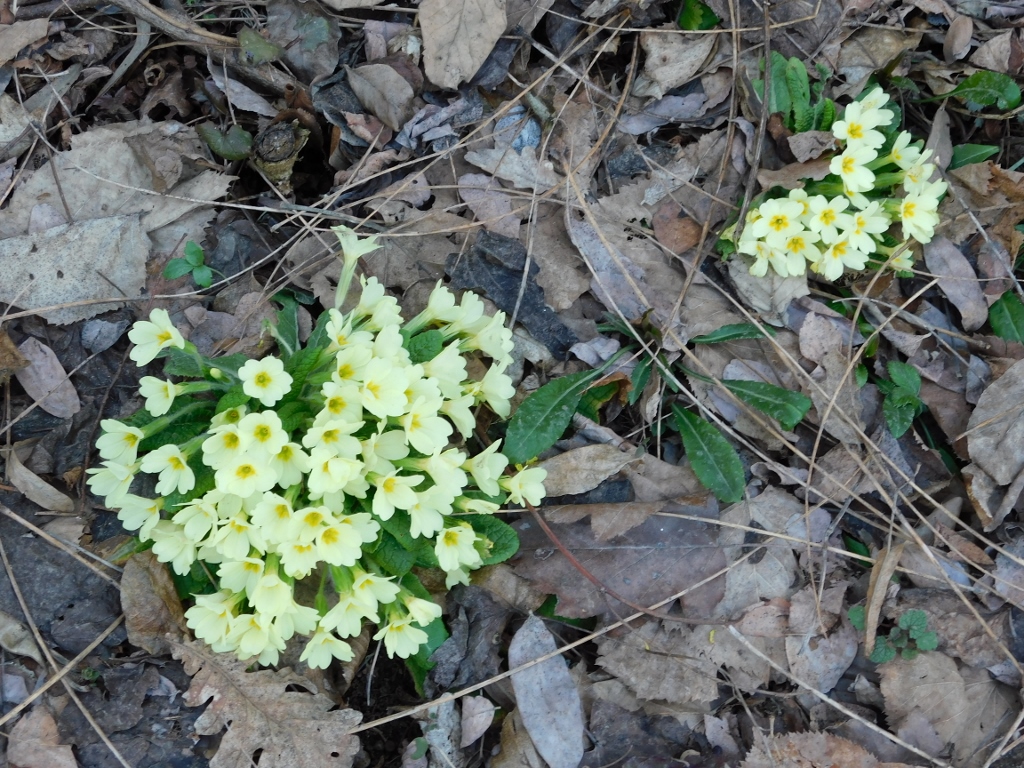 Common primrose (Primula vulgaris)
Common primrose (Primula vulgaris)
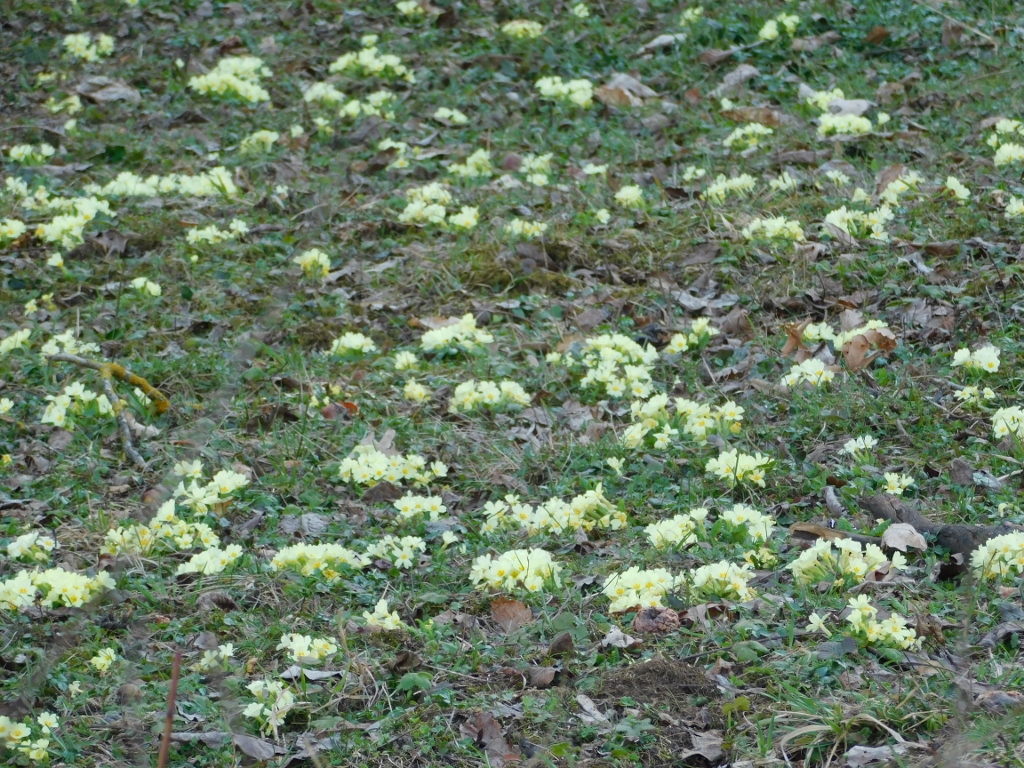 A meadow full of common primrose (Primula vulgaris)
A meadow full of common primrose (Primula vulgaris)
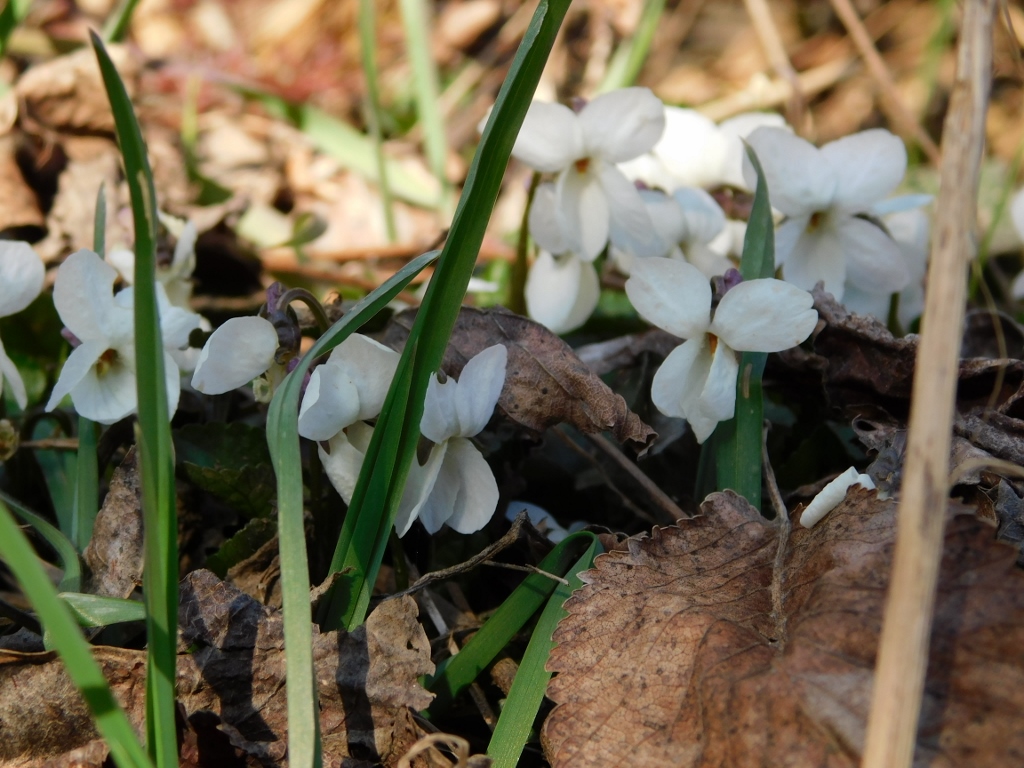 Sweet violet, white variant (Viola odorata)
Sweet violet, white variant (Viola odorata)
Soon I reached inhabited areas.
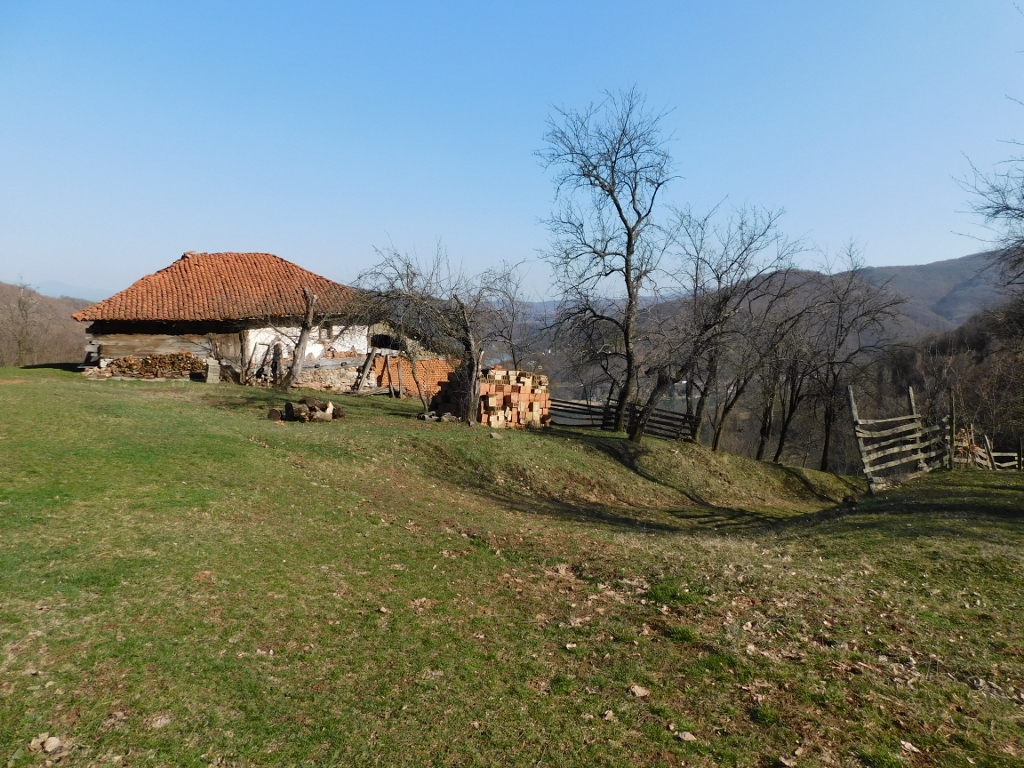 Trail leading by somebody’s holding
Trail leading by somebody’s holding
Now, from a low elevation I could see the Zapadna Morava winding around the “fingers” or promontories. When I came here for the first time, many decades ago, these parts were completely wild and uninhabited. Over time, people started to build their holiday houses here.
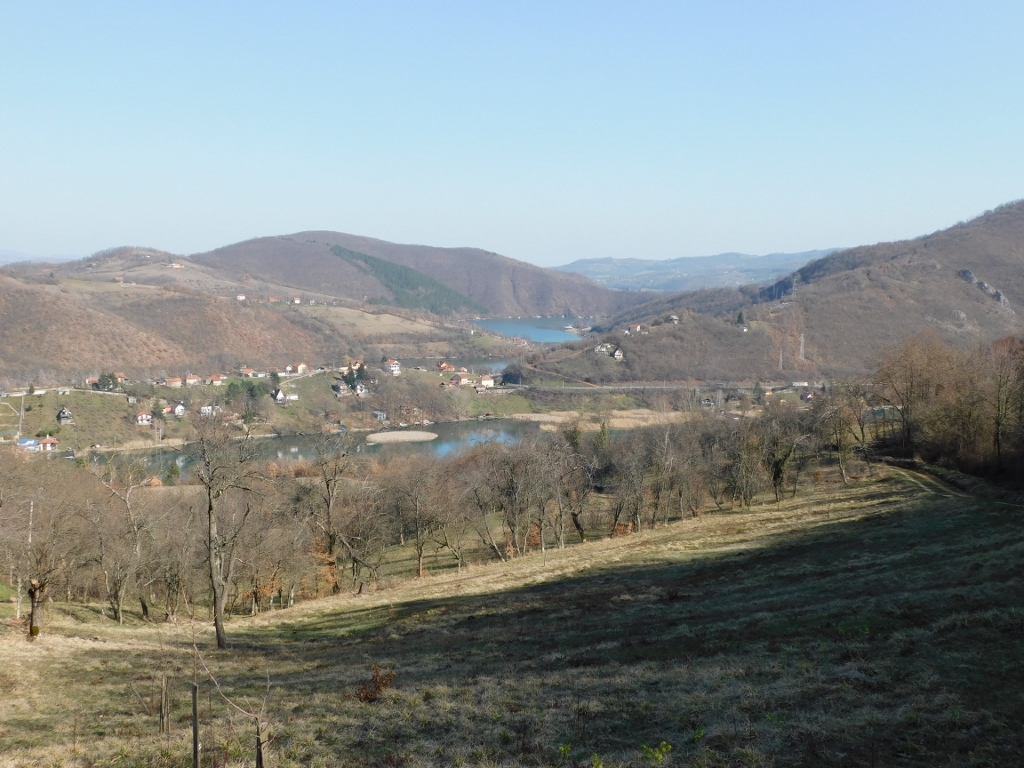 Meanders of the Zapadna Morava, as seen from a low elevation
Meanders of the Zapadna Morava, as seen from a low elevation
And then by a gate leading to a holding, came out running two small furballs that barked joyfully and played around my feet. It was interesting to see how they squeezed through some holes in the fence. I “scolded” them gently, telling them that they had to go back home, since I could not see their owners and I worried lest they started to follow me. There were some “negotiations,” but eventually they withdrew to the realm of the holding from which they came. I could continue without any concern.
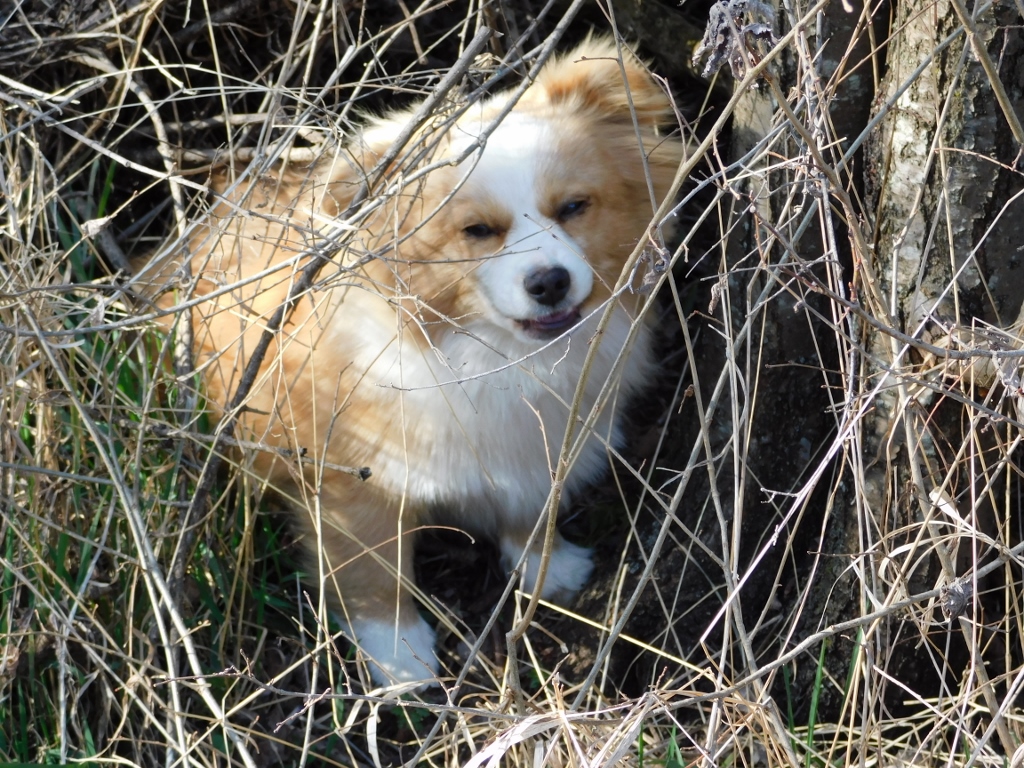 One of the two “furballs”
One of the two “furballs”
Here I reached an asphalt road that follows the Zapadna Morava and soon I got to a fork. In the next photo, the road to the right goes through a tunnel and on to Ovčar Banja, while the road to the left leads to the monasteries of St. John and the Assumption of the Theotokos.
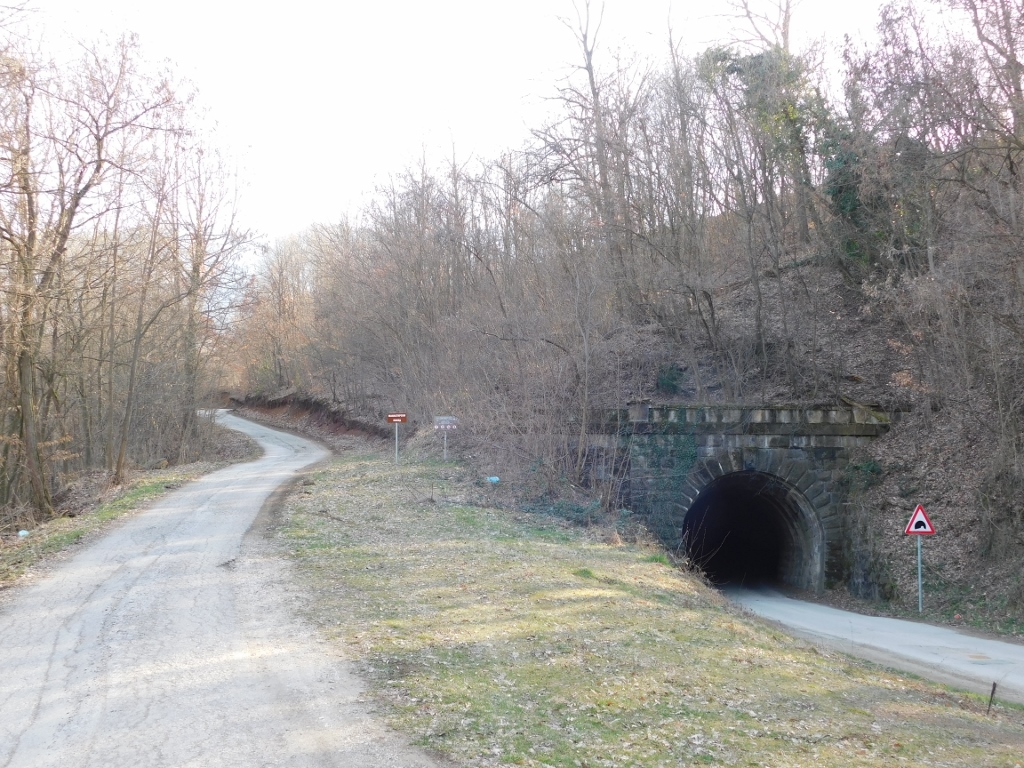 First I follow the road to the left and later the one to the right
First I follow the road to the left and later the one to the right
The Monastery of St. John, as well as the Monastery of the Assumption of the Theotokos, are located on the same extended “promontory” of the Zapadna Morava. Moreover, the latter is situated at the very top of the elevation on one of these two “fingers” that the Zapadna Morava winds about and it can be seen in the photos of the meanders I took from the top of mount Kablar.
However, since I descended from up high, it was quite clear to me that I would no longer climb on this day, so I decided to go and visit only the Monastery of St. John. Taking into account I planned anyway to return to the area around Čačak on the last day following precisely the asphalt road that runs by the left bank of the Zapadna Morava, which is used in order to get to the Monastery of the Assumption of the Theotokos, I quite liked the idea of getting to this monastery by car. But, I did go on foot to the Monastery of St. John.
I think that the Monastery of St. John in the Ovčar-Kablar Gorge is my favourite. I remember my earlier visits to the monastery and how every time I was taken by the peace and serenity which I regularly felt when entering the monastery’s yard.
This time, I minded a little the noise coming from the traffic across the river, but the monastery was still just as pretty as I remembered.
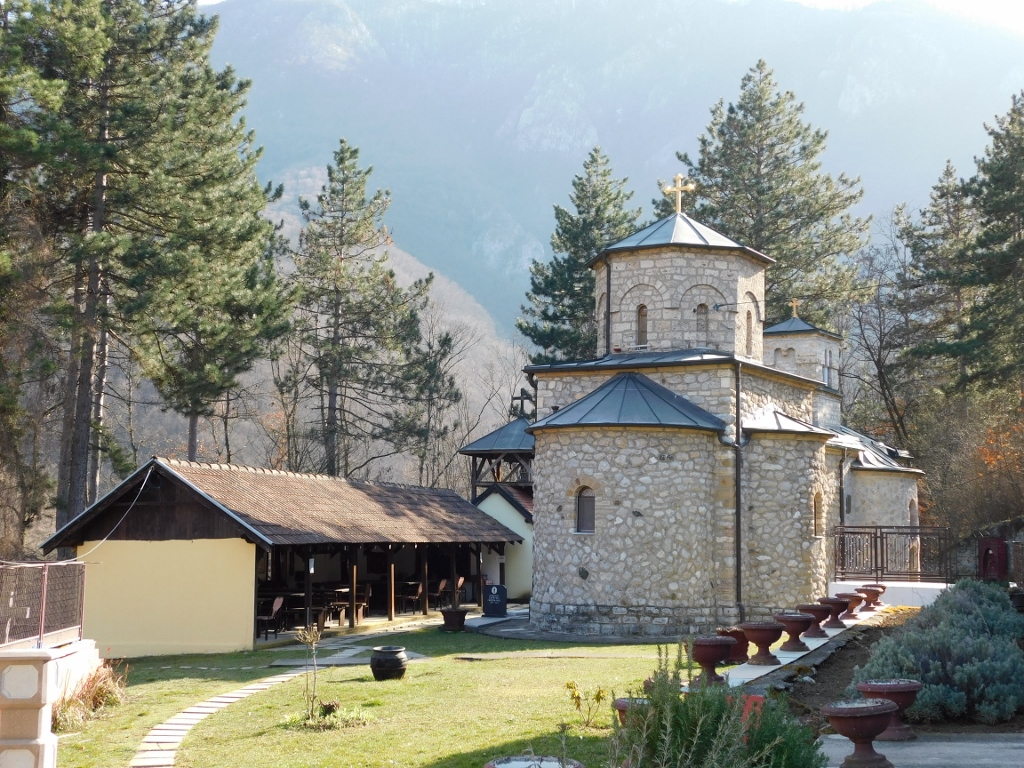 Monastery of St. John
Monastery of St. John
It is not known when and who exactly built the Monastery of St. John (Jovanje), but judging by some tombstones, it is believed that it existed even before the Battle of Kosovo in 1389, although it was mentioned in an Ottoman defter for the first time around 1540. The old church dedicated to St. John the Baptist was submerged when Međuvršje hydro-electric plant was built and the reservoir was created in 1954, but the one that can be seen here today was built in 1957 and in terms of its style it is considered the most beautiful in the Ovčar-Kablar Gorge.
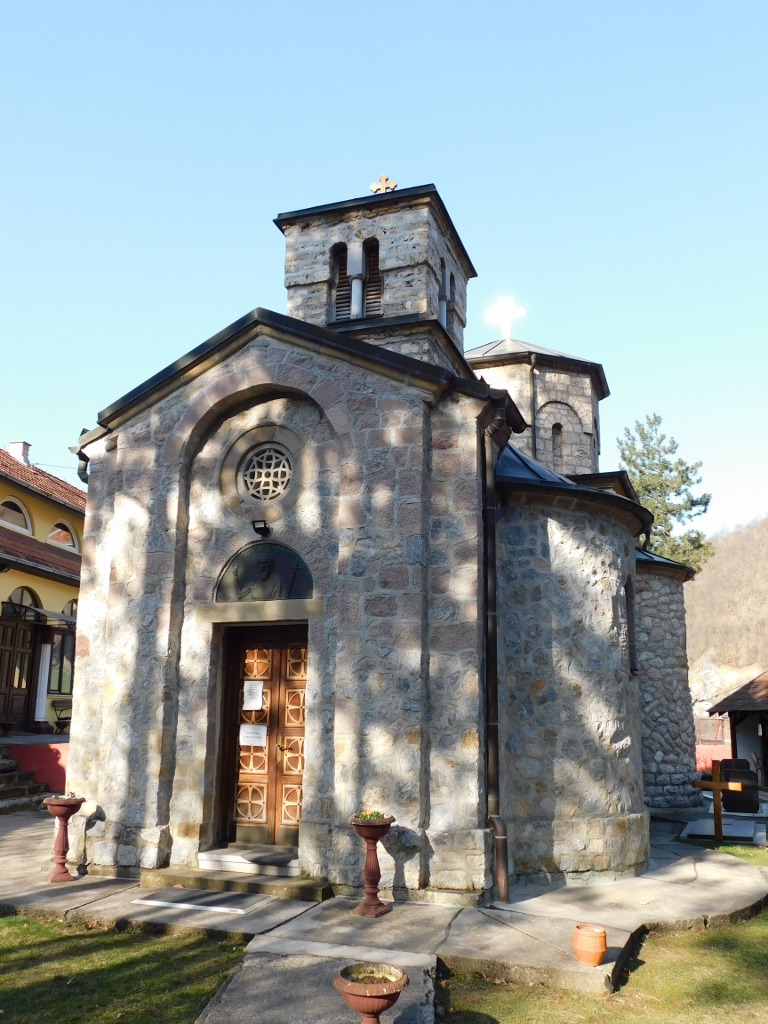 Church of St. John the Baptist
Church of St. John the Baptist
I entered the church, having already put on my special long skirt that I carry with me for the purpose before entering the yard. Although I did not see any nun around, I wanted to abide by the rules. After all, it was their home and I was a mere guest. Rules should be obeyed.
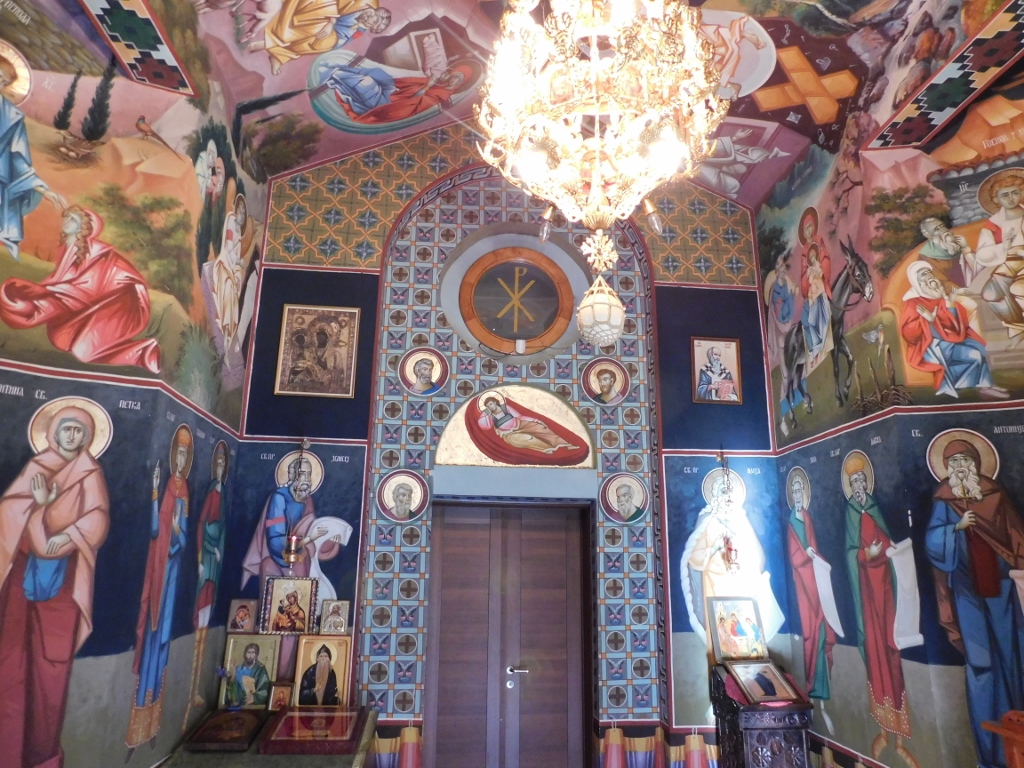 Church of St. John the Baptist, details
Church of St. John the Baptist, details
In the photo above, left of the door, it is possible to see the miraculous icon of the Theotokos Quick to Hear that was brought here in 1917.
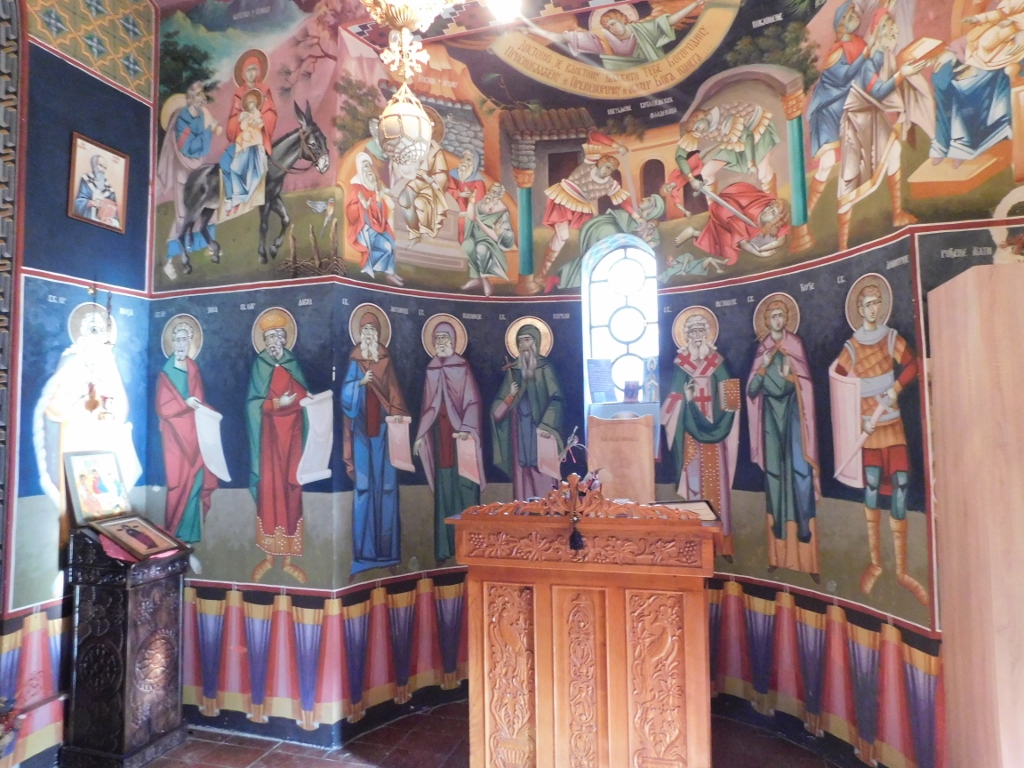 Church of St. John the Baptist, details
Church of St. John the Baptist, details
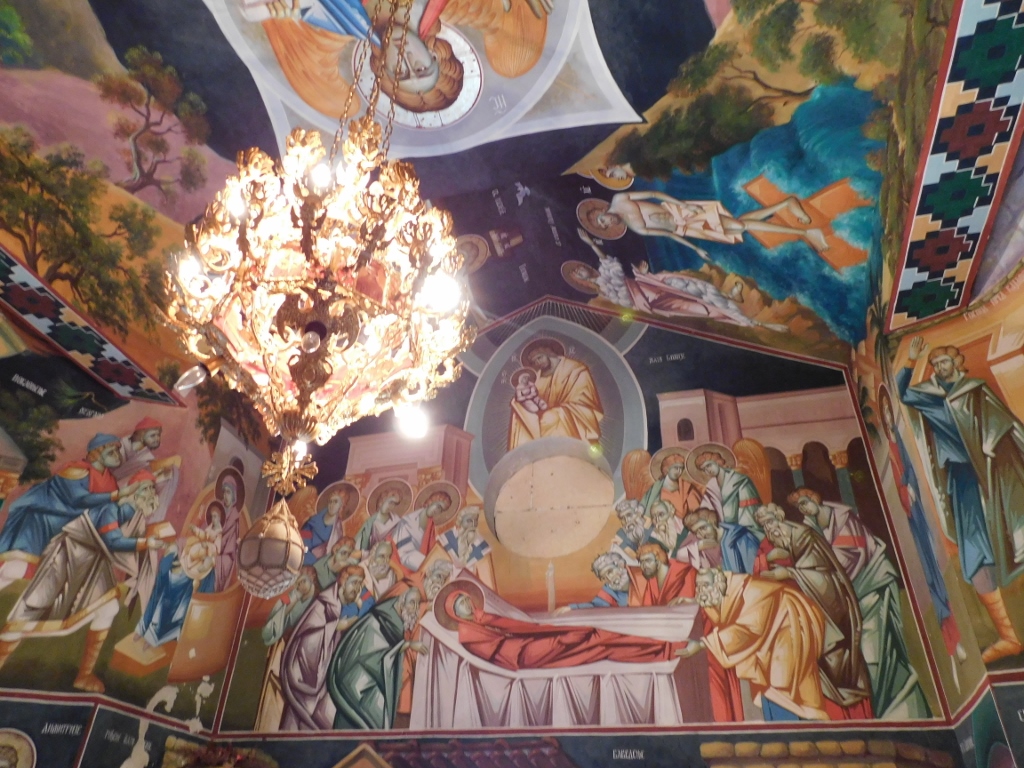 Church of St. John the Baptist, details
Church of St. John the Baptist, details
After I had visited the church, I saw where the candles were, so I took a couple and paid for them by putting the money into a box next to the candles.
Having lit the candles, I started to look around and so I noticed what I was looking for – a drinking fountain. When I got to it, I saw a nun and so I asked her if the drinking fountain worked. It did, so I filled up my bottle, for I had already drunk up all that I had on me and I needed the liquid.
I got back to the main road and first I had to go through that tunnel that may be seen in one of the photos above. I always found this tunnel interesting for it has a curve. At the beginning, as well as at the end, there is some light coming through, but in the middle there is no light whatsoever and one can either walk in pitch black (which I used to do in the past and which creates a very unusual sensation) or turn on the torch on the mobile phone (which I did this time).
As a reminder, here is also the map with marked places that I visited during this trip:
Be as it may, it was all flat now. Long, but flat. I just had to endure and reach the hotel. It’s not as if I had any real choice. Along the way I had a nice view at the Zapadna Morava where it is very lively during summer when there are numerous boats floating around.
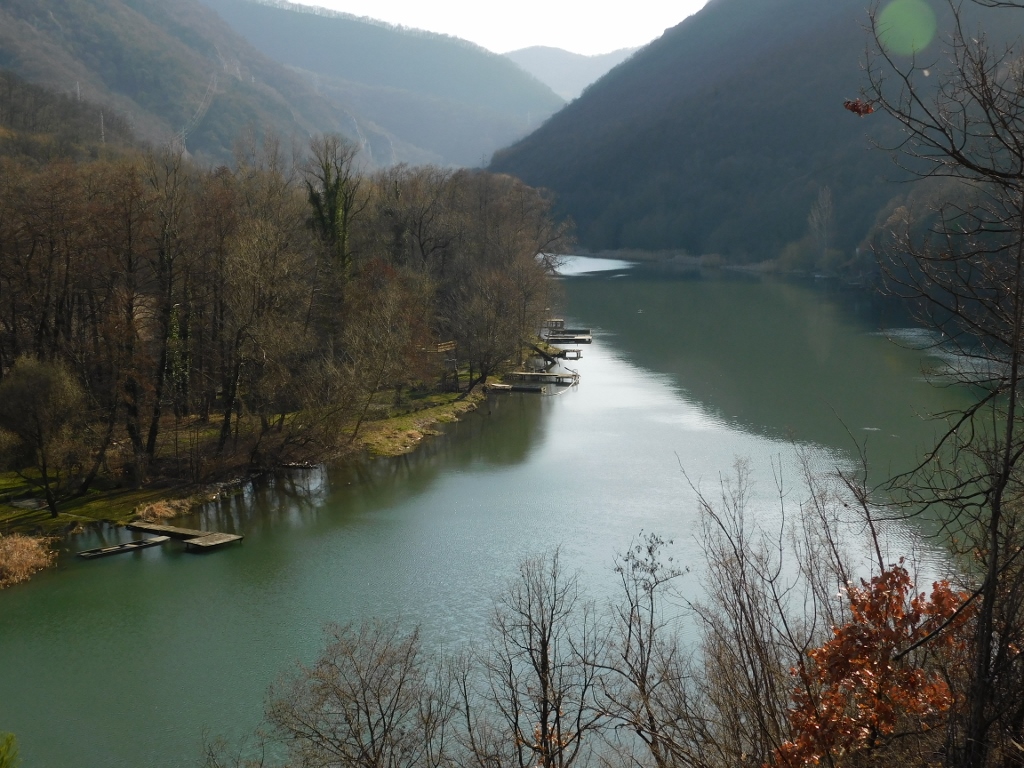 The Zapadna Morava in the Ovčar-Kablar Gorge
The Zapadna Morava in the Ovčar-Kablar Gorge
I walked past the lodge of the Mountain Club “Kablar” from Čačak. I must admit that I do not remember this lodge from my earlier visits, but you can see that it is a modern lodge at which hikers can stay comfortably.
Already from this lodge, by the main road, there is a side road leading lower towards the riverbank or rather towards the official entrance in the Monastery of St. Nicholas. Still, I entered the monastery from the back end, which was only a matter of habit.
The Monastery of St. Nicholas (Nikolje) is very beautiful and this beauty of it is particularly visible when seen from the other bank of the Zapadna Morava along which runs the road from Čačak to Požega. Unfortunately, the road is very narrow and there is no parking lot that would be a good viewpoint. Therefore, the monastery may be seen only from a vehicle or a coach that pass by. The best view is when the trees still don’t have their foliage.
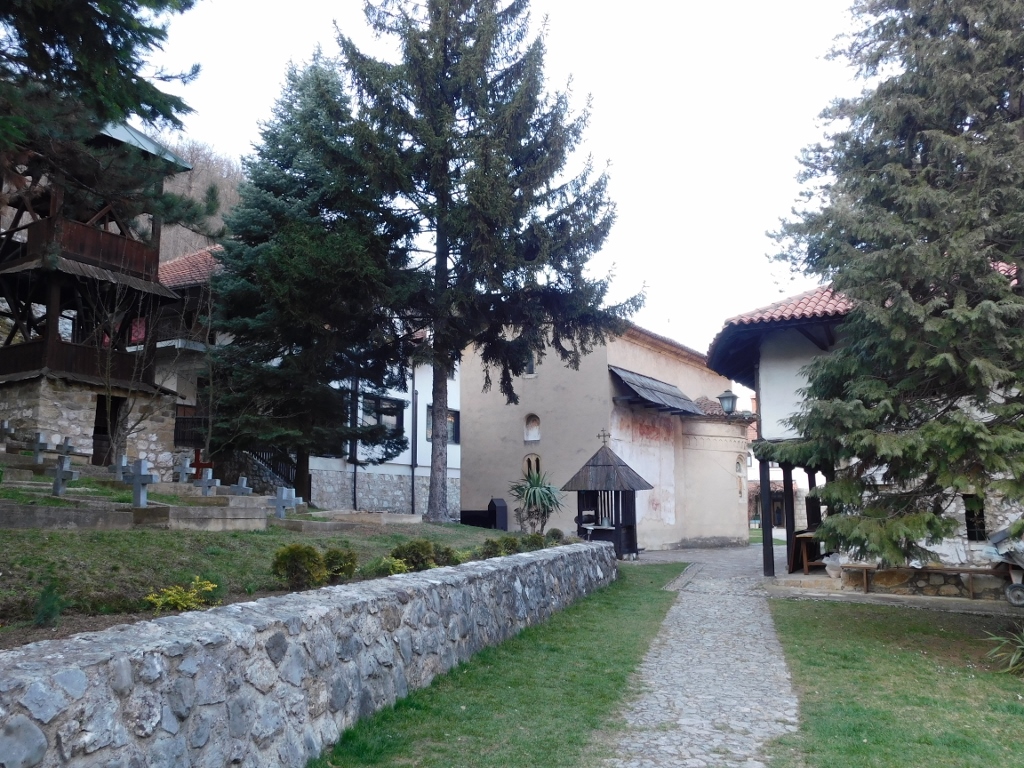 Monastery of St. Nicholas
Monastery of St. Nicholas
The Monastery of St. Nicholas is a cultural property of great importance. It was first mentioned in 1489 and for this reason it is believed that it may be the oldest one among the monasteries of the Ovčar-Kablar Gorge. The original church had a trefoil ground plan and it was fresco-painted in 1587. Later, a narthex with an upper floor entered via a porch on the south side was added. The facade of the porch and the ground floor of the narthex were painted in 1637.
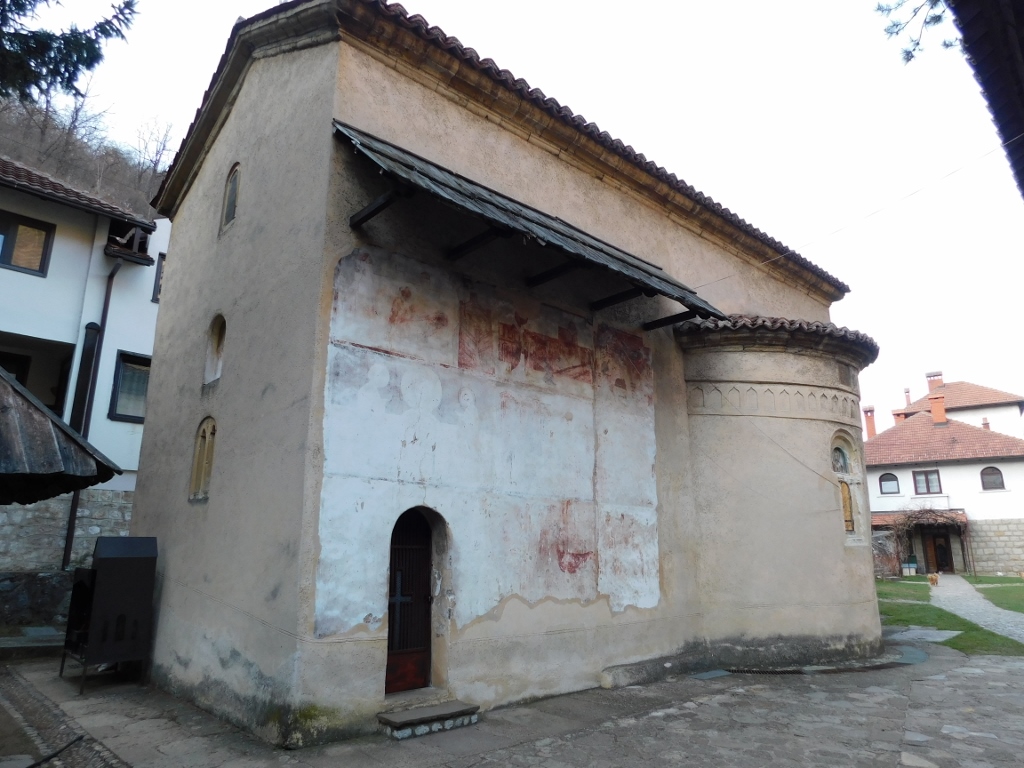 Monastery of St. Nicholas
Monastery of St. Nicholas
The major restoration of the monastery took place during the reign of Prince Miloš in 1817, as well as a few decades later. It was at this time that some additions were made, such as the decoration of the conches with a line of plaster blind niches.
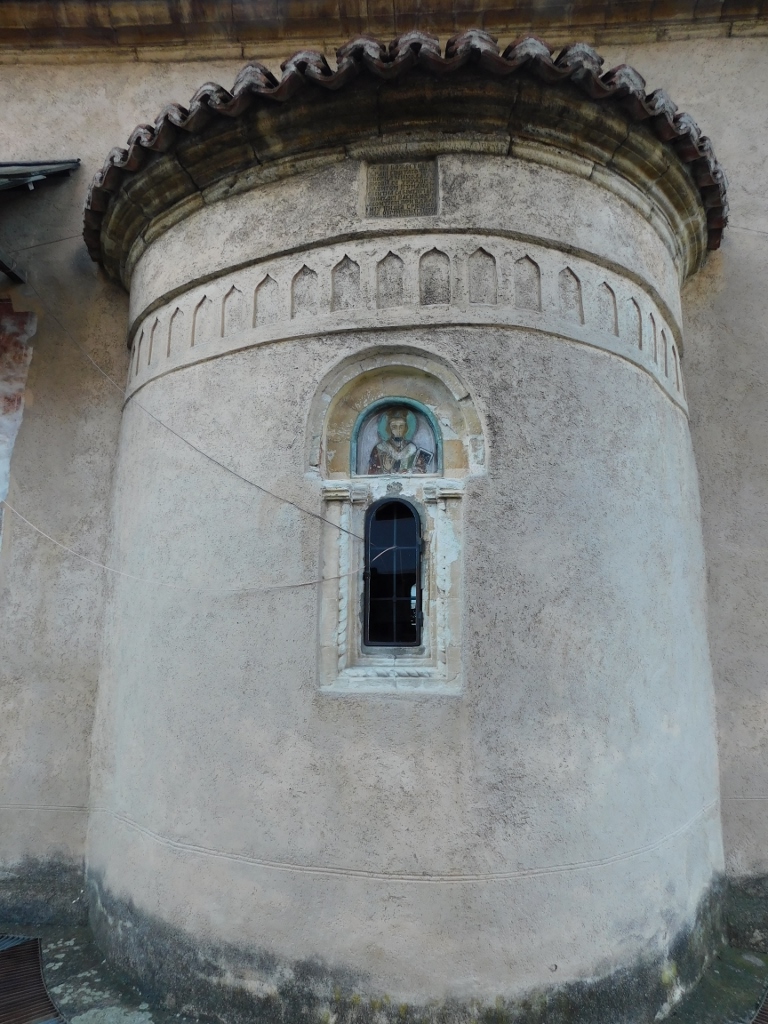 Monastery of St. Nicholas, south conch with the blind niches
Monastery of St. Nicholas, south conch with the blind niches
The new iconostasis was installed in 1826 and the church was opulently painted.
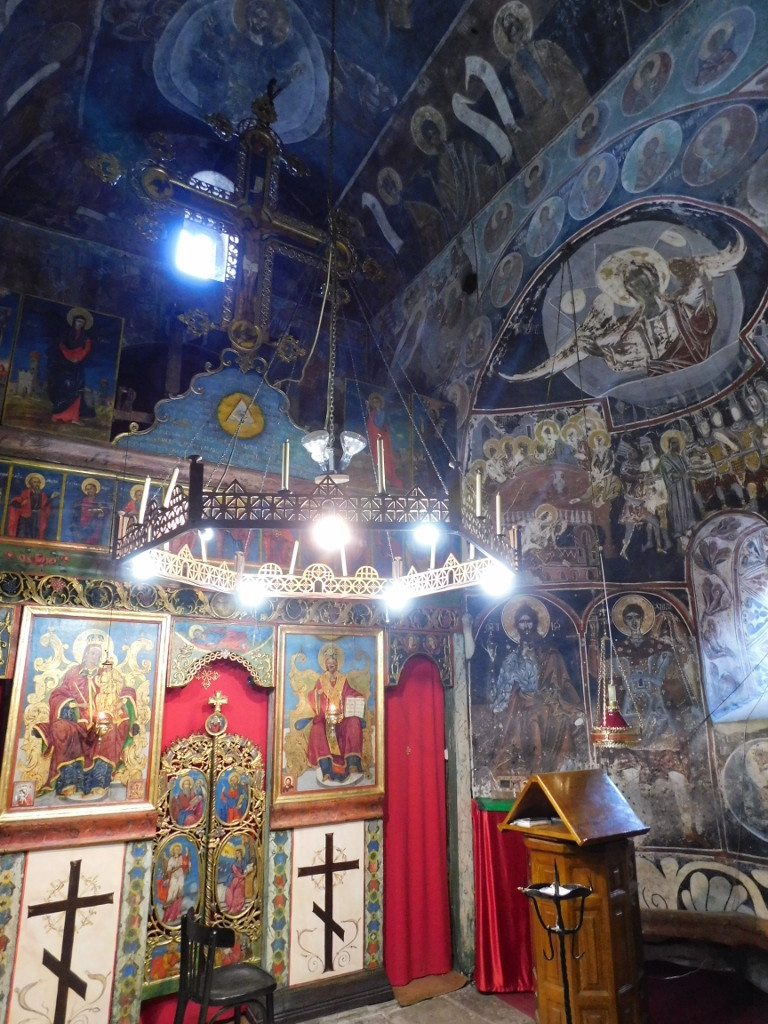 Monastery of St. Nicholas, a detail
Monastery of St. Nicholas, a detail
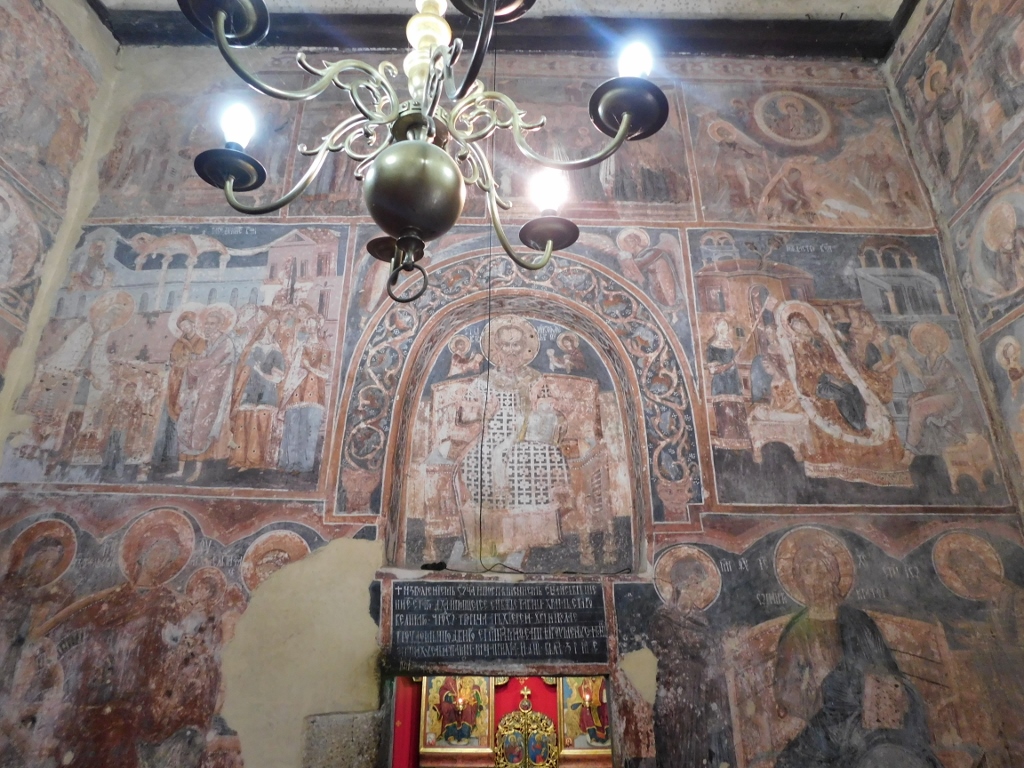 Monastery of St. Nicholas, a detail
Monastery of St. Nicholas, a detail
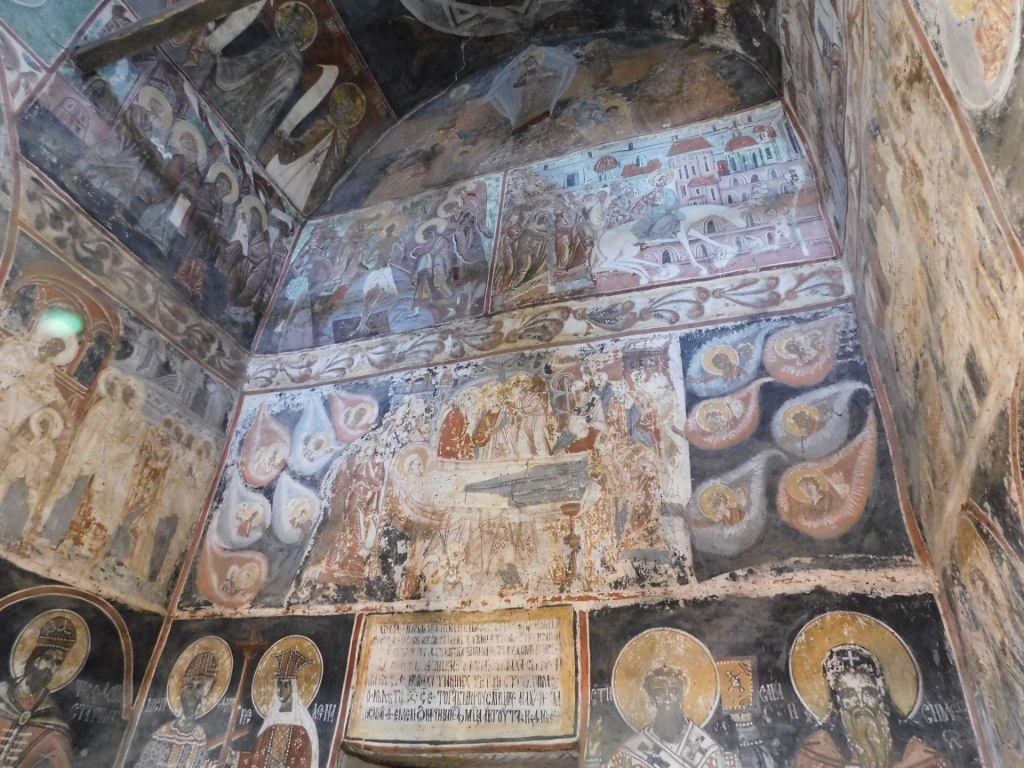 Monastery of St. Nicholas, a detail
Monastery of St. Nicholas, a detail
Within the monastery, there is a board saying that the monasteries of the Ovčar-Kablar Gorge were visited in 1820 by Vuk Stefanović Karadžić, famous Serbian language reformer and collector of the Serbian oral tradition (poems, stories, etc.), who also left some records about the monasteries.
As I’ve said, the monastery went through a major restoration during the reign of Prince Miloš and this link between the prince and the monastery is corroborated by the grave of his five-year old son that is located directly opposite the front facade of the church.
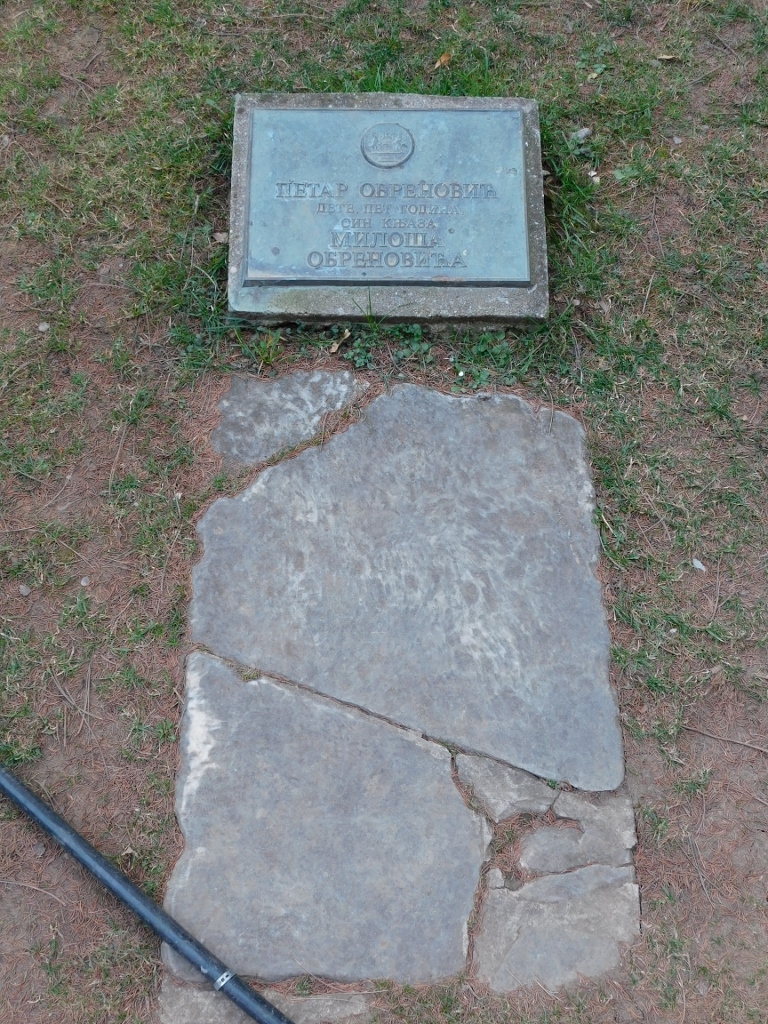 Grave of Petar Obrenović, son of Prince Miloš
Grave of Petar Obrenović, son of Prince Miloš
Here I also lit candles and it was interesting that this monastery applied different rules in comparison to the previous one. Namely, here, the candles both for the living and for the dead are lit at the practically same level because “in the God’s eyes we are all alive” as I was told by a nun who had joined me in the meantime.
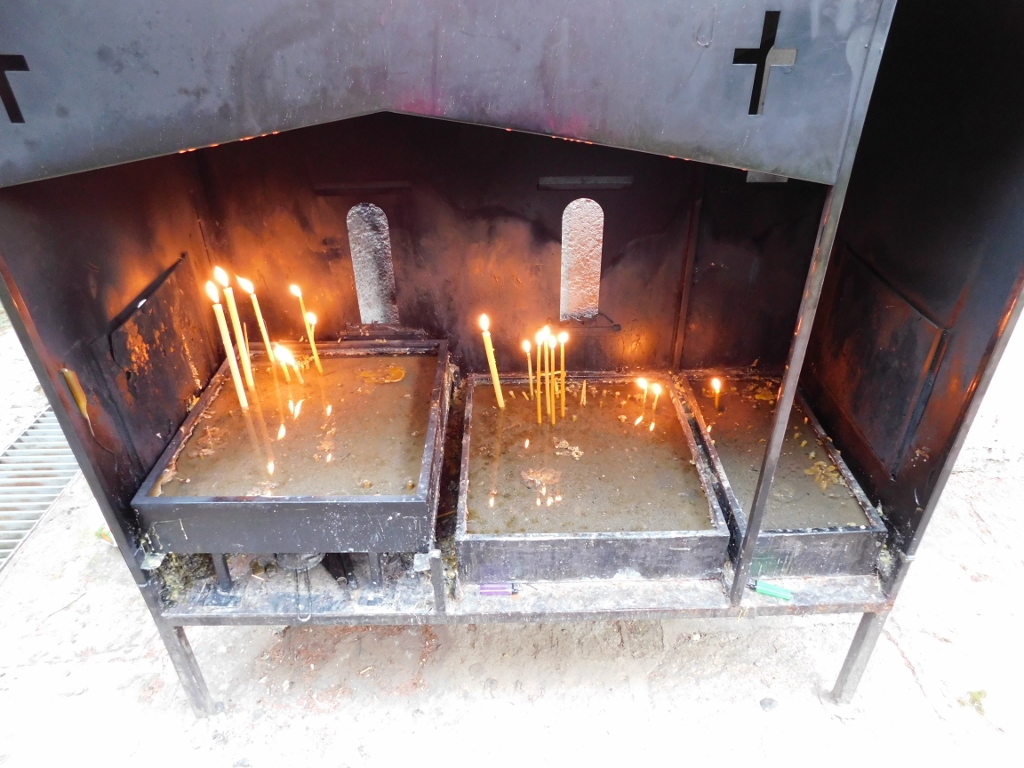 Places for lighting candles at the Monastery of St. Nicholas
Places for lighting candles at the Monastery of St. Nicholas
Opposite the entrance into the church, there is a dormitory with an upper floor which is considered as one of the most beautiful examples of vernacular architecture of that period.
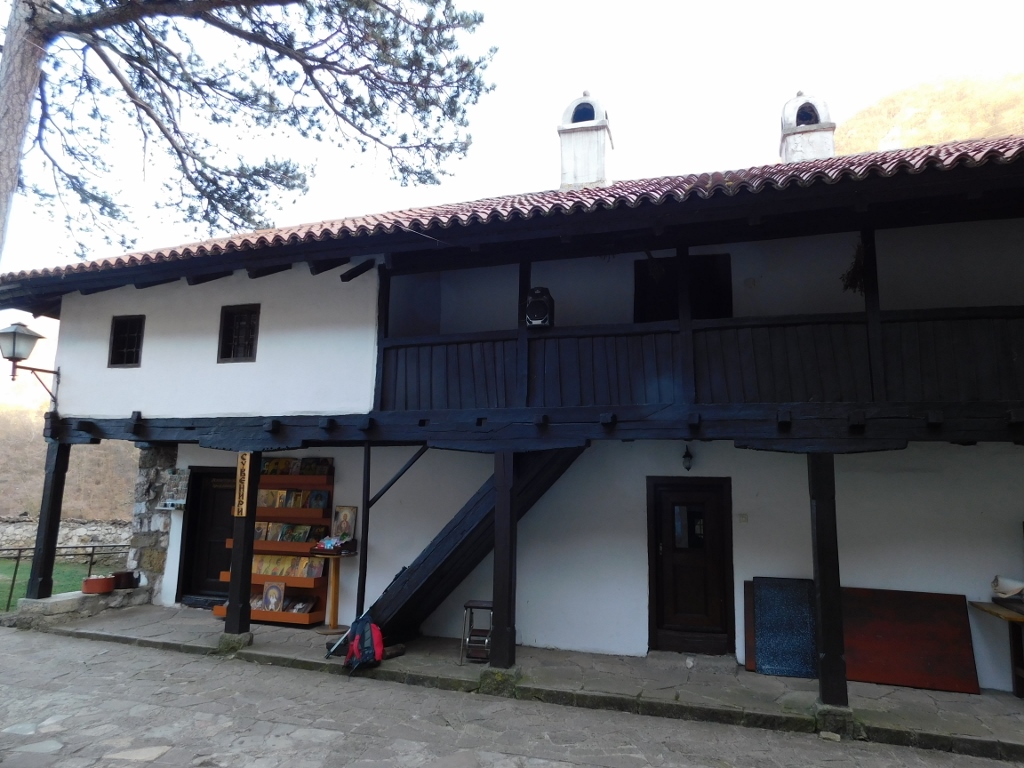 Old dormitory
Old dormitory
Here, in addition to church souvenirs, it was also possible to buy various products made of medicinal plants (tinctures, drops, lotions, etc.) prepared either at the monastery or for the needs of the monastery.
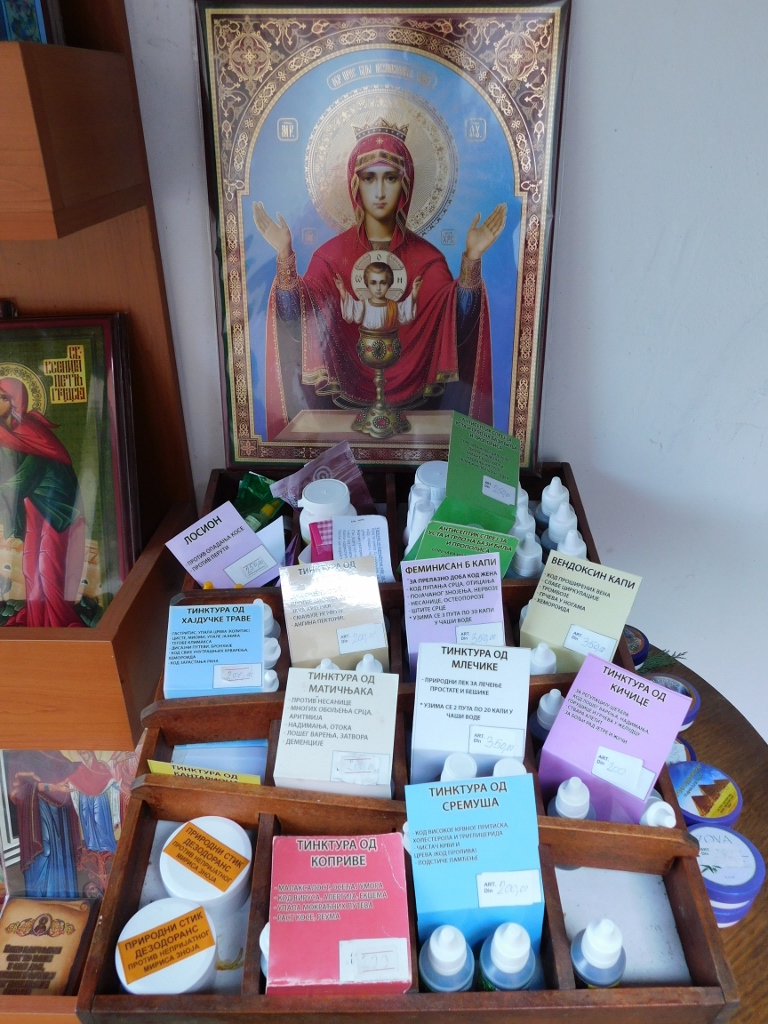 Healthy preparations offer
Healthy preparations offer
Having bought a few of these things, I walked around the yard a little where I could see some interesting sights.
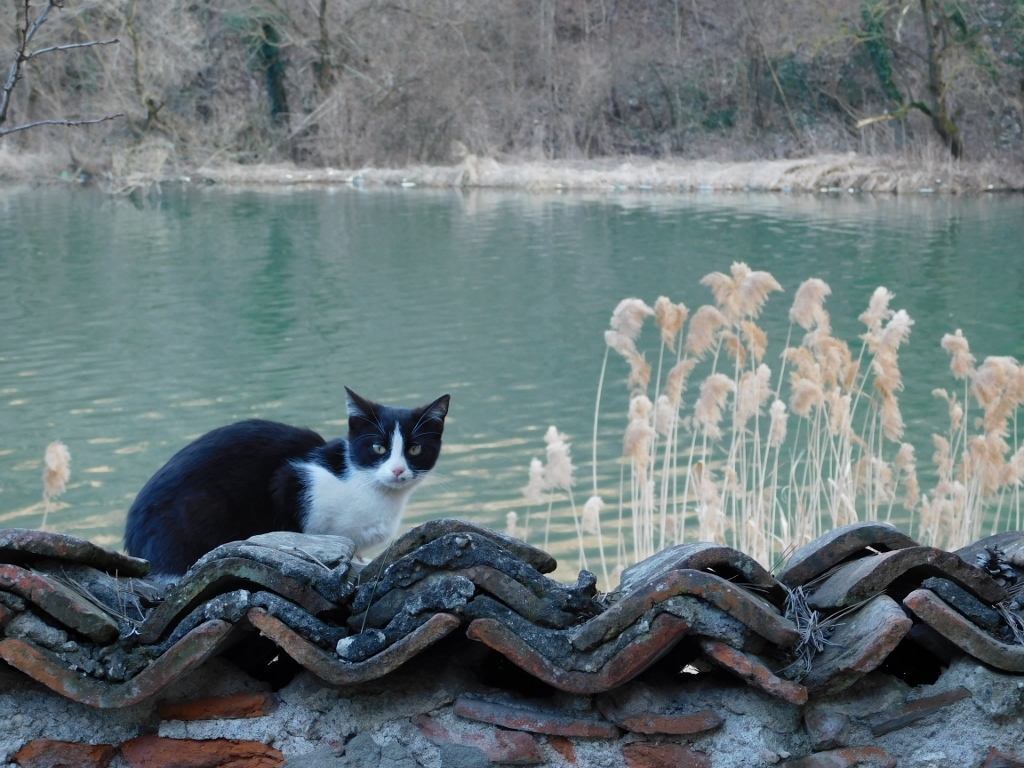 Respite by the Zapadna Morava
Respite by the Zapadna Morava
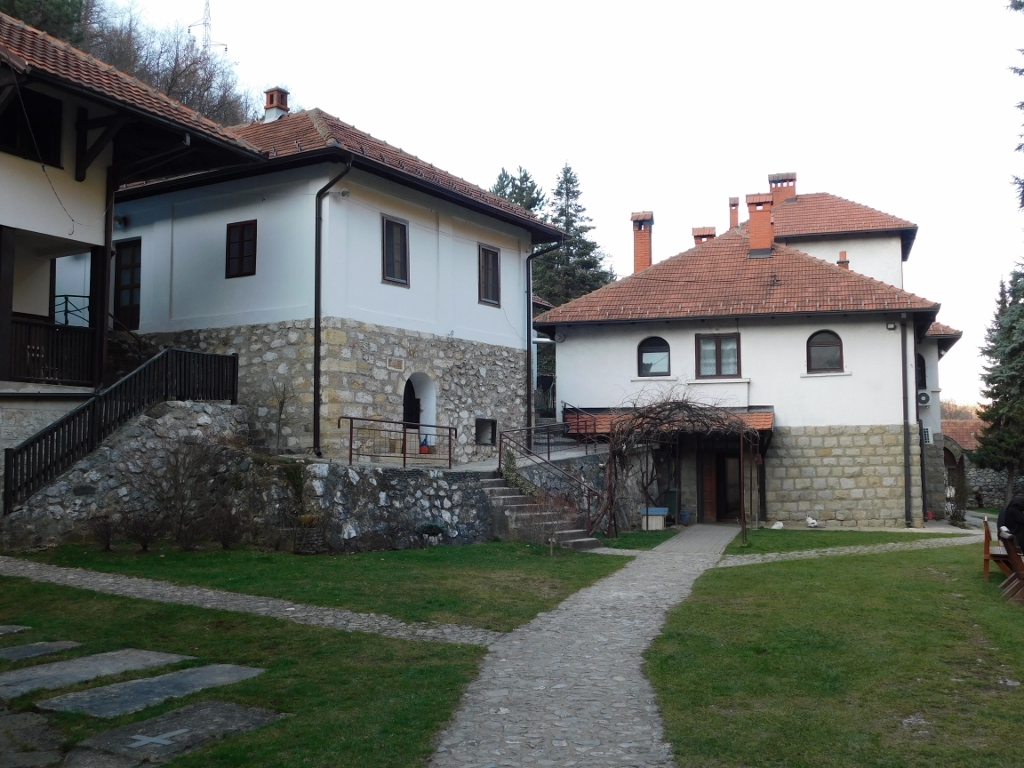 Monastery of St. Nicholas, the yard
Monastery of St. Nicholas, the yard
Then I returned to the road again and continued walking to Ovčar Banja which is around 2 km away from here.